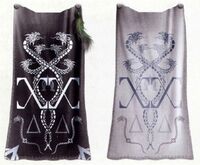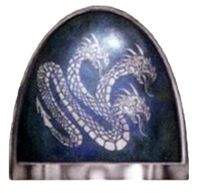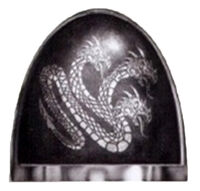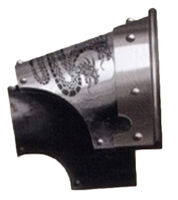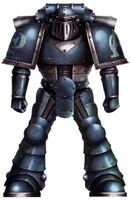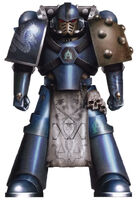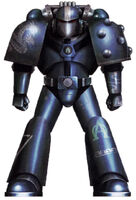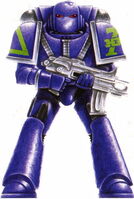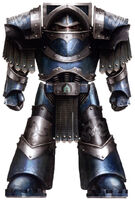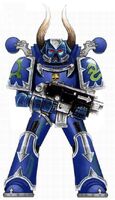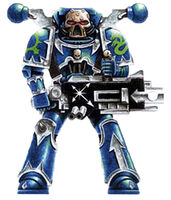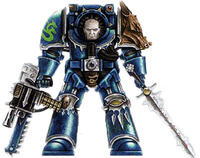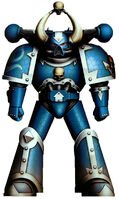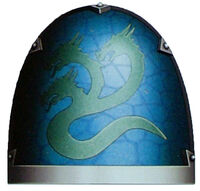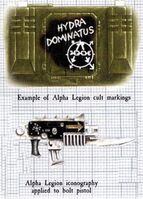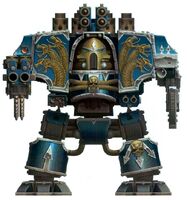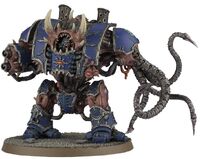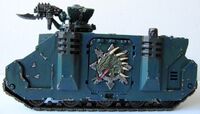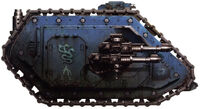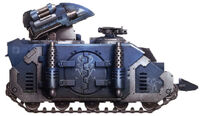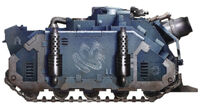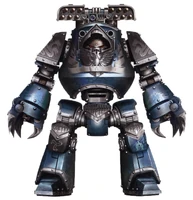(→Notable Alpha Legion Operatives: added Jalen from Tallarn: Ironclad) Tags: Visual edit apiedit |
Tags: Visual edit apiedit |
||
| Line 300: | Line 300: | ||
*''Fear to Tread'' (Novel) by James Swallow |
*''Fear to Tread'' (Novel) by James Swallow |
||
*''Legion of the Damned'' (Novel) by Rob Sanders |
*''Legion of the Damned'' (Novel) by Rob Sanders |
||
| + | *''Tallarn: Executioer'' (Novella) by John French |
||
| + | *''Tallarn: Ironclad'' (Novel) by John French |
||
*''[[Warhammer 40,000: Dawn of War]]'' (PC Game) |
*''[[Warhammer 40,000: Dawn of War]]'' (PC Game) |
||
*''[[Dawn of War - Soulstorm|Warhammer 40,000: Dawn of War - Soulstorm]]'' (PC Game) |
*''[[Dawn of War - Soulstorm|Warhammer 40,000: Dawn of War - Soulstorm]]'' (PC Game) |
||
Revision as of 16:29, 29 July 2015
"The Imperium is riddled with corruption and hatred. We have made sure of it."
- — Anonymous Alpha Legion Chaos Space Marine
The Alpha Legion is the Chaos Space Marine Traitor Legion about whom the least is known. The Alpha Legion was once the XXth Legion of Astartes created during the First Founding by the Emperor of Mankind to carry out his Great Crusade to reunite all of humanity in a new Golden Age under his rule. They are experts in infiltration and their armies contain many Chaos Cultists in addition to regular Chaos Space Marines. The Alpha Legion's Primarch was named Alpharius, who was actually one of the identical twin Primarchs Alpharius Omegon, two brilliant and secretive sons of the Emperor, one of whom was reportedly later killed after end of the Horus Heresy by Roboute Guilliman, the Primarch of the Ultramarines. Despite its seeming allegiance to Chaos, a closer scrutiny of the Alpha Legion's known history indicates that their seeming service to Chaos Undivided might actually be the greatest deception they have played upon the Imperium.
Legion History
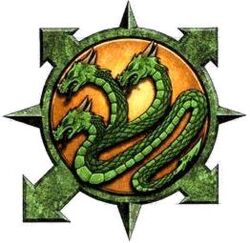
Badge of the Alpha Legion
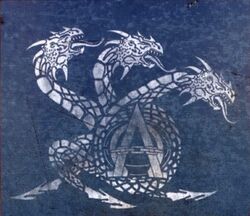
Pre-Heresy Badge of the Alpha Legion

Alpha Legion Colour Scheme

Pre-Heresy Alpha Legion Colour Scheme
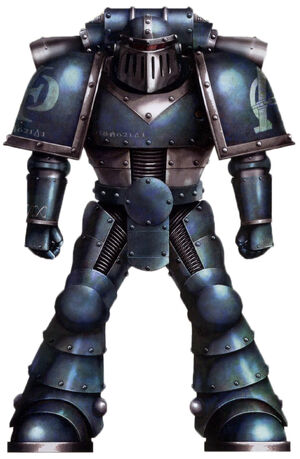
Unification Wars-era XX Legion Colour Scheme
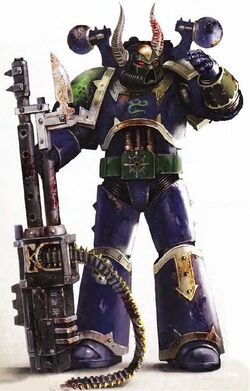
An Alpha Legion Chaos Space Marine with his Autocannon
The Ghost Legion
Before the vile treachery of Horus came to being, the XXth Legion, its formation, and purpose was shrouded in mystery and bellicose concealment from the rest of the Imperium. This secrecy was colluded -- as is evident -- by the highest circles of power. Indeed, it cannot be doubted that it was the Emperor's will. It is believed by many Imperial scholars that the secrecy surrounding this "outsider" Legion and its designed purposes would later serve to conceal the dark transformation at its heart which was long in its gestation. This malediction and the increasing addiction for the evincing of its own preternatural use for subterfuge and destruction, only worsened after the ascension of Horus to the rank of Warmaster. The Alpha Legion became a twisting serpentine force of formless shadows, as dangerous and deadly as the multi-headed monster of ancient myth that in latter days became its modus operandi and its icon. It was a weapon neither first the Emperor nor later the Warmaster could control.
The pall of mystery surrounding the XXth Legion can be traced back to their creation. The last known of the gene-seed strains used in the creation of the Legiones Astartes at the end of the Unification Wars, factors relating to the XXth Legion were kept beyond the usual secrecy and security that the Emperor chose to surround the Space Marine project with. The XXth along with the XVIIIth (Salamanders) and VIth (Space Wolves) proto-Legions, were formed and established largely in separation from the rest of the Legiones Astartes and is generally thought created to very specific ends and purposes. What plan of the Emperor's lay behind this action cannot now be known, and even at the dawning of the Imperial Age, this was one of many secrets the Emperor kept both from the Imperial Court and many of his own advisors, and the Primarchs themselves. These Legions were kept veiled and distant from the beginning, breeding distrust between them that, save in the case of the XVIIIth Legion -- who would later become the widely renowned Salamanders Legion -- would never disappear. In the case of the Alpha Legion, it would instead worsen over time. This first mystery would breed others, and questions would continue to go unanswered not simply about the XXth Legion's methods and nature, but about the use to which it was put in its earliest days.
Of the early decades of the XXth Legion on Terra and during the re-conquest of the Sol System almost nothing can be said with any accuracy whatsoever, and even the cluster of myths and rumours that would later grow to surround the Legion's activities is absent. What remains instead are a few sparse but suggestive fragments, anomalous records of unknown Legiones Astartes units carrying out targeted strikes, abductions and assassinations, both on Terra and beyond, and reports of Space Marine units answering to no known masters or Legion allegiance passing through war zones on high priority missions and under the writ of unassailable clearance codes which broached no question. Rumour and supposition even surrounded the designation "Alpha", which by some records is connected with the XXth proto-Legion from a very early period. This, aside from the numerous occult and arcane associations and significance that certain sources choose to derive from this fact, ties into another, more prosaic, potential association dating back to the hidden work of the Emperor's own gene-labs.
It is apparent from numerous extant sources that during their creation, each nascent proto-Legion after the Primus or Ith Legion (later the Angelis Tenebrium or Dark Angels), was raised first to active service in a staged process of testing and trials before the full active force was created through mass recruitment from amongst Terran populations loyal to the Emperor's cause. Each stage of creation would result in expansion of the gene-seed implantation on progressively larger groups of Neophytes. The last of the these preliminary stages was, according to sources, the "Alpha" induction. This was in essence believed to be the first non-experimental implantation, and its purpose was to create a proto-Legion of Astartes at minimum fighting strength to be field-tested in open battle. Tellingly, there is no recorded evidence that the XXth pattern gene-seed group, although having been approved by the Emperor after its limited battle-tests, was ever ordered to expand to full implantation, or received an allotted intake region of Terra for mass recruitment as the rest would do during the early years of the Great Crusade. This then effectively limited the XXth Legion to a body of around 1,000-3,000 Legionaries and effectively side-lined them while their contemporaries underwent rapid expansion and deployment through the opening phases of the Great Crusade. The question then remains, why?
Almost certainly it was not a question of gene adaptation; the extant sample records place the gene-seed implantation success for the XXth pattern as being in the highest end of the recorded spectrum. The evidence would indicate it was certainly far superior to certain other developed typos (the difficulties experienced by the VIth (Space Wolves) and IXth (Blood Angels) genetic patterns being documented elsewhere). Likewise, their battlefield performance was stated high, removing the other most obvious likelihood for considering the XXth proto-Legion a failure. There are three outstanding theories that have been posited as to why the XXth was not apparently expanded to full Legion strength during the early Great Crusade which may each have some merit. The first is entirely mundane, and is simply the sabotage of suitable manpower. The recruitment assignments of the other Legions during the period now covered most of the suitable-genetic and cultural candidates of both Terra and the Sol System, and some sort of disaster (which has been redacted from official Imperial records) had proven the folly of attempting to recruit Legiones Astartes stock from potentially tainted sources.
The second is the suspicion that some hidden problems, or potential flaw had been discovered which prevented the proto-Legion's expansion -- although this in many ways seems unlikely for it is to suggest the Emperor was either unable or unwilling to solve such a problem and equally unwilling to ruthlessly eradicate a failed experiment as He had done before. The third theory is that the XX was deliberately preserved separately as an isolated unit for other specific or military reasons possibly to act as a strategic gene-seed reserve or indeed a control group as some have suggested. This theory also posits the possibility that the XXth proto-Legion was held back to undergo some further development and conditioning unique to them that the rest of the Legiones Astartes was restricted from by design. There remains evidence that this last "Alpha" stage-Legion of the Emperor's led to the later development and eventual creation of his personal cadre of transhuman protectors, the Legio Custodes.
A War in Shadow
Once the Great Crusade was fully underway after 798.M30 and the first of the great Expeditionary Fleets had set out en masse to bring unity to the galaxy, the XXth Legion then disappears from official history for many decades. However, there seems to be a connection between them and certain shadowed events during the Great Crusade that have never been adequately explained by the official record, even to what was known to the highest echelons of the Imperium, including even the Throne of Terra itself. Some suggest that during this time the XXth Legion, without their lost Primarch, had a secret role to play in ensuring the Imperium's future. It has been suggested since the earliest days of the Great Crusade and the Emperor's great vision of a united humanity free of the shackles of torment of nightmarish enemies, as well as the threat of enemies without, there has remained the danger of the enemy within as has been proven time and again. Evidence for this hypothesis can be seen by the fact that the nascent Imperium of Man was plagued with rampant insurrection, petty rebellions and the dangerous plots of Renegades and Traitors. Such enemies had slunk into shadowed obscurity following bitter defiance and crushing conquests during the bloody wars of Unification, but yet plotted vengeance. Many were twisted by lust for power or tainted by exposure to the horrors beyond, and sought to pervert the Imperial Truth to their own ends.
None thought that such hidden foes could strike at the heart of the Imperium until the so-called incident that reached into the gene-seed reserve that was nearly to doom the IIIth Legion (the future Emperor's Children) occurred -- an act which many have since attributed to the actions of a secret enemy within. It was not long into this dark event in the fourth decade of the Great Crusade (ca. 838.M30) that scattered and unspecified reports of anomalous Space Marine Legion activity came to light. These actions were uniformly tactical scale operations, which occurred far from the front lines of the Great Crusade by small detached units, ranging between squad and company in size. The warriors who carried them out were doubtless of the Legiones Astartes, identified by their power, abilities and wargear, but their identity remained concealed. These mysterious Legionaries carried little or no unit markings or heraldry, or in some cases wore unrecognised markings not in the official record. In some stranger instances they operated under a "false flag", wearing the livery of a known Legion, often amid a war zone where that impersonated Legion was operating but without that Legion's knowledge, license or command. These actions were uniformly of a covert nature; surgical strikes, assassinations, espionage, sabotage, the recovery of unknown artefacts and the abduction of important individuals or entire groups for some unknown purpose. Such strikes, carried out both at the front lines and within the already Compliant worlds of the Imperium, were deadly accurate and seldom left any witnesses alive to tell directly of them.
The predations of what came to be known in certain circles as the "Ghost Legion" were rare -- at least those that came to light were few -- and protests by local Imperial commanders or Planetary Governors against them were rebuffed or simply ignored. It was suggested by some within the Imperial High Command that the XXth Legion was at work, but as other, specialised agencies of the Imperium such as the Legio Custodes, the Securitas Inconcensus and the Officio Assassinorum rose to power and established themselves, aspects of this unknown force faded and began to enter myth, although they never entirely disappeared. If such a "Ghost Legion" existed as a coherent entity, then it represented the frightening prospect of a Legiones Astartes force whose specialisation was to act in a way that was distinctly different from its peers, and to do so in secret. If this force was indeed the XXth Legion, then it may have been operating in the shadows of the Imperium for more than a Terran century, building a wealth of influence and experience akin to any other Space Marine Legion and undertaking a secret war at once part of and parallel to the Great Crusade itself.
What it became, what it learned during these years remains unknown, but even if this supposition is true and not merely a conspiracy theory fashioned after the fact in regards to what was to follow, it poses yet another question -- why was the purpose of this "Ghost Legion" in its particular role ended? Had it simply been replaced by more specialised and newly founded Imperial powers, or had it become perhaps too unpredictable, uncontrollable or even too dangerous in its current form? Had the Great Crusade's need for front-line battle Legions to add to its war effort proved too great to allow the XXth Legion to remain in the shadows, or had the long awaited discovery of their Primarch necessitated the change? Irrespective of the truth, the twisting coils of the Alpha Legion rose from the darkness and into the light of the Imperium.
Unity and Lies
There remains much that is contradictory in the accounts of the first open actions of the Alpha Legion as a force of the Legiones Astartes in its own right. Official accounts found in both the datalooms of the Logistica Corpus and the more prosaic work of the Remembrancers place the Alpha Legion's appearance as an active Legion force in its own right to either the decade immediately preceding the commencement of the Farinatus Extermination or as appearing as an unexpected reinforcing power during the darkest days of the Third Rangdam Genocides. This represents a discrepancy of some thirty sidereal years, but in many regards makes the Alpha Legion the last of the Legiones Astartes to be recognised as a military entity in its own right by a considerable margin, and also the last to be officially re-united with its Primarch (again accounts widely differ as to the exact timing and conditions of this occurrence).
The XXth Legion's chosen name -- the Alpha Legion (in the ancient form commonly meaning the "first" or the "beginning" in the glyph pattern) -- seems an almost deliberately perverse jest in the light of its late inception, as does the name by which its Primarch was generally to become known -- Alpharius. Some who have studied the history of the Traitor Legions have chosen to see the adoption of this naming convention neither as irony nor deliberate contradiction of fact, but rather as a statement of ambition and intent. Alpha also means "Primarcy", and "Supreme", particularly in conjunction with the ancient glyph called the Omega and the pre-Dark Age of Technology sigil known as the "Æternus". This sigil, which was used particularly in the earlier displays of the XXth Legion's heraldry, carries other hidden meanings not limited to themes of unity, continuum and indestructibility. It contains within it the pre-Imperial "sacred geometry" of the serpent of power and knowledge coiling around the pillars of physical reality and truth. The serpent also has, since time immemorial, been seen as a symbol of treachery, secrets, strife and lies. The ancient Terran mythic serpent of devastation that could not be slain -- for when one head is cut off, two more would uncoil in its place -- would provide the XXth Legion's other great icon-type, and one which would become dominant by the time of the Horus Heresy; the symbol of the Hyrdra. Even then, within these symbols alone could be divined layer upon layer of hidden meaning and the promise of baleful intent, ambition and destruction; so would it be with the Alpha Legion.
The Hydra
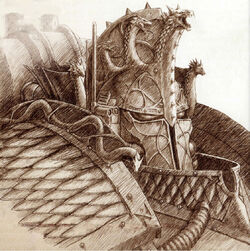
An ancient Remembrancer's illustration of Alpharius, Primarch of the Alpha Legion Space Marine Legion during the Great Crusade, taken from Carpinus' Speculum Historiale
Of the many mysteries that surround the Alpha Legion, the most fundamental and key enigma is the question of the Alpha Legion's Primarch, Alpharius. Of all of the Primarchs who remained to draw blood against each other in the Horus Heresy, of Alpharius the least is known for certain. Furthering this mystery and the outright deception perpetrated by Alpharius, many reliable accounts of his origins differ. One such account of the finding of Alpharius circulated secretly between the houses and factions of the Imperial Court on Terra, which states that his discovery was an accident of the Luna Wolves Legion prior to the end of the Great Crusade and the beginning of the 31st Millennium. By this, Alpharius was the leader of a confederation of human systems whose fleet of warships, no match in size or scale to Imperial vessels, managed through trickery and ambush to ingloriously lay low one of the outlying Luna Wolves Battleships as it entered an unnamed star system. Responding to this unforgivable defeat, Horus himself and his fleet gave chase, only to find themselves mired in ambush after ambush, tricked into deadly traps and chasing shadows until Horus' own flagship, the mighty Vengeful Spirit, came under attack. In the ensuing confrontation, the Luna Wolves smashed the enemy fleet's desperate attack aside, but in the confusion a single assassin broke into the flagship, and through stealth and murder managed the impossible task of fighting his way clear to Horus' command chamber and slaughtered his Justaerin bodyguards before Horus himself was forced to confront him. But Horus did not slay the attacker but recognised him instead for a brother. He had found the last Primarch! The new arrival called himself Alpharius and claimed to have been travelling this region of space for many years. However, he remained tight-lipped as to where he had come from. Various worlds in that locale were subsequently brought into the Imperial fold, but Alpharius always denied that any of them were his homeworld of origin. The conglomeration of planets he had been leading was persuaded to join the Imperium with little bloodshed.
Another account torn form the mind of an Alpha Legion Centurion captured by the Legio Custodes after the Fall of the Seraphin tells the story of the finding of Alpharius. It speaks of a nameless Dead World at the edge of the Mandragoran Stars whose civilisation rose and was wiped out by bloody hands long before Mankind first walked on Terra. On this nameless orb, the nascent Primarch fell into the shattered ruins of a fallen city murdered long ages ago. Utterly alone, voiceless and without aid, he was forced to survive against the tortuous elements of the desolate world and the predations of the hungry ghosts of the charnel pit into which he had been consigned. His solitude was only broken after many long years by a new star falling from the heavens; a corsair ship of degenerate half-human Renegades and alien mercenaries intent on plundering the dead ruins for whatever worth might remain amid the shatters. Instead they found only death at the young Primarch's hands, and Alpharius gained their weapons, their knowledge and their vessel as his own, and with it he set out in search of he who had made him.
Two other accounts, found encrypted within the pages of certain volumes of the suppressed work of memetic corrosion known as the Transit of the Human Soul through Strife, or the Codex Hydra as it is sometimes known, offer differing contentions. The first is that the lost Primarch was deposited on a thriving tech-oligarchy world known as Bar'Savor, but before his first decade of life there was done, the skies of Bar'Savor darkened as the nightmarish xenos worm-creatures known as the Slaugth descended to feed. Capturing the young Primarch, a being alone strong enough to resist them, the Slaugth kept Alpharius as a curiosity, twisting his mind with their horrors and enslaving him and tutoring him as a living weapon to sow strife and discord on their victim worlds before they fell upon them to feast.
It was the Emperor Himself who at last liberated him, His gold Battle Barge ramming into the heart of the vast stone ship of the foul xenos to break it open, the Emperor's wrath like that of a vengeful god of legend in retribution for what had been done to His son. For long years after, Alpharius remained at his father's side as the Emperor undid what had been done to mar His creation. This account also offers a contradictory version of events, saying that Alpharius alone, unfinished in some way, had been spared or at least some part of him had remained behind though gravely injured when the rest of the Primarchs were scattered across the stars by unknown hands. Here, in the shadow of Terra, he grew and was nurtured alone of the Primarchs by the Emperor Himself, his existence a jealously guarded secret even from those closest to the Emperor, lest the dark fates move against him. Upon his maturity he became the Emperor's own secret hand and His greatest shield, until he was at last parted from his father, his destiny to fulfill. It is unknown which one of these accounts are true and which are lies. The recorded facts suggest none of these accounts are real and they are but a few of the phantasms that purport to be the secret truth of Alpharius' past. Like the most potent of falsehoods, perhaps they contain a grain of truth within them, a hint at a greater secret yet.
The Emperor & Alpharius
Whatever the truth, following his public discovery, eventually Alpharius was taken back to the epicenter of the ever-expanding Imperium and reunited with his father, the Emperor. There was the usual rejoicing, pomp and circumstance, but records on Terra suggest that the two spent little time together. Alpharius was quickly sent to take command of his Legion, while the Emperor had many pressing affairs of state by this time. Alpharius and his twin-Primarch brother Omegon shared the same physical appearance and together served as joint-Primarch of the Alpha Legion. The Emperor was aware of Alpharius Omegon's secret; but whether the creation of the twin Primarchs was intentional or not remains a mystery. The two Primarchs supposedly shared one soul, with Omegon acting as Alpharius' second-in-command of the XXth Legion. The existence of the twin Primarchs of the Alpha Legion was known only to the members of the Legion itself, and was a well-kept secret even from the other Legions. The new Legionaries under their command were tall and strong, and were reminiscent of their Primarch, and possessed their gene-sire's cunning intelligence. When Alpharius Omegon took command of the XXth Legion, it was eager, zealous and completely committed to embracing the Primarch's command and combat philosophy. Alpharius led his Legion, created in his image, to the outer reaches of the Imperium and was eager to join battle and emulate the glories of the older Legions. In battle, this "youngest" Legion, driven by its mysterious and taciturn Primarch, became renowned quickly for its discipline and strict and impenetrable organisation and regime, which emphasised the unity of the Legion and its wider actions over the individual Astartes in every aspect. Its hallmark was a relentless application of force and a terrifying level of co-ordination between its warriors and war machines. This capacity for combined arms warfare, speed and surety of attack, were matched only by a mastery of the darker arts of war -- of sabotage and ambush, stealth tactics and assassination. Also evident was its desire for secrecy and talent for misdirection. It kept its distance from its fellow Legions, even when tasked to directly fight alongside them, and it is certain many fostered a sinister willfulness, and beneath the facade, the shadow of mockery.
The Harrowing
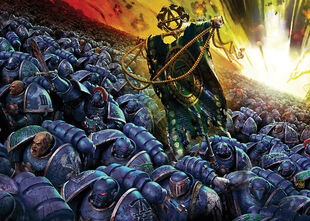
The Alpha Legion initiating a "Harrowing", a final assault during an Imperial Compliance, from a hundred directions at once
Unlike the other Legiones Astartes in which could be discerned patterns of Terran culture and the origins of their intake of recruitment, with the hand of their Primarch's direct influence or that of their Founding wrought upon what had gone before, where the Alpha Legion and their Primarch began or ended, were to all intents and purposes, one and the same. Their hallmarks were unity, power and the confusion that outsiders encountered in dealing with them. Right from the very beginning, even the Imperialis Logistica could not confirm even the most basic details of the Legion with any certainty, be it their Legion's preliminary spheres of recruitment, its livery or anything remotely approaching a true gauge of its operating strength. It was a Legion seemingly sprung whole in its entirety, as if from nowhere, complete with tens of thousands of fully equipped Legionaries and a capable war fleet that operated with veteran skill. Even the name under which it operated seemed in doubt, for while the name of "Alpha Legion" gained common currency, official battle reports saw it operating under self-given titles such as the "Unbroken Chain" or more sinister appellations such as "The Harrowing," as it called itself in the xenocidal campaigns of the Perfidian Gap Extermination. Likewise, many accounts occur of individual members of the XXth Legion referring to themselves to outsiders by the name of "Alpharius" or simply as "One of Many", often infuriating and confounding the forces they served alongside. Whether this policy of anonymity was the result of the unusual focus the Legion placed on unity and solidarity in its ranks, or mere outright addiction to secrecy or a deliberate attempt to mask its numbers is unknown.
Other contrary accounts exist which belie this practice, however. Multiple sources of evidence exist of names originating in ancient long-thought lost dialects being used by the XXth Legion both in communication and as personal cognomen for its members. Further, on at least one occasion, analysis of after-action reports involving a battalion of the Alpha Legion (in this case serving alongside the Klarkash Imperialis Auxillia against the Khrave at Memlock), the names and code words used by its Legionaries were later found to exactly correlate to the population of a recidivist human world the Alpha Legion itself had previously exterminated. The reason for this falsehood or the function this macabre practice served remains unknown. Such attitudes of deception -- in their broadest sense at least -- appear to have been tacitly accepted and tolerated by the Emperor and later by Horus as the Imperial Warmaster, though to what true ends remains unclear. In battle the Alpha Legion proved itself capable of wielding a devastating mixture of subtlety and overwhelming force, revelling in both meticulous planning and the exercising of imaginative cruelty in war.
Quickly, the Alpha Legion developed an unmatched reputation among the Legiones Astartes -- save perhaps by the Raven Guard -- for the use of espionage, infiltration and sabotage in its strategic planning. But where the Raven Guard sought to use such tactics to achieve victory without unnecessary attrition, or spare a human population it sought to liberate, the Alpha Legion had other, darker, purposes in mind. To them, such covert tactics seemed almost a deadly game of prelude. Where it could, the Alpha Legion would spread confusion and disorder seemingly for its own sake as well as any tactical gain it conferred, or even perhaps for the bloody spectacle of it. They maimed and bled the foe, forced them to chase phantoms and turn on each other in panic before they struck. Such tactics often brought the Alpha Legion's target to an agonised fever pitch while simultaneously robbing them of their real strength and forcing them into such vulnerable configurations as the Alpha Legion wished. Then would come the kill. Often this final attack, or "Harrowing", would be in the form of an assault from a hundred directions at once, a blizzard of different tactics and attack plans used against a foe either utterly unaware of the true danger or already brought to the brink of chaos. The result was almost inevitable catastrophe for the Alpha Legion's victims, as the full might of the XX Legion would then descend at the point of their enemy's greatest weakness, and what would follow would be, to the onlooker, more akin to murder than battle. To their allies, the Alpha Legion represented a shifting, protean entity of uncertain identity and active deceit, coupled with undeniable military strength, unknowable goals -- and to some observers -- unproven loyalty -- a dangerous combination and one that did not breed trust. To their enemies they were a true nightmare; a foe that could strike from any direction, a foe that seemed to thwart any stratagem and strike at weakness no matter how well hidden. The Alpha Legion was a foe that knew neither mercy, nor honour, nor quarter, and always seemed to delight in destruction for its own sake, and the chaos and anarchy it could inspire before the death blow.
Although its history as an active Legion is a short one compared to many -- at least under its own name -- it proved quickly determined to match any of its brethren in glory -- or perhaps more accurately prove itself superior to them -- and its tally of victories mounted with surpassing speed. The Alpha Legion, ever watchful, was far from adverse from studying the strengths of their fellow Legions, and their weaknesses, and adapting the weapons and tactics of the other Legiones Astartes to their own ends. In this the Legion was not so different in strategic observances as the Ultramarines Legion and their master Roboute Guilliman, although it is doubtful that the Lord of Ultramar would have cared much for the comparison, even before the two Legions later came to bitter bloodshed. Such zealousness to prove themselves as part of the Great Crusade at any cost, and the often over-elaborate and needlessly complex and malign way in which the Alpha Legion chose to wage war, saw them quickly gain infamy more than fame. This, coupled with growing distrust due to their insular and deceptive nature, brought rivalry and acrimony between the Alpha Legion and much of the rest of the Legiones Astartes. As time passed, the relationship between the Alpha Legion and its peers soured further. The nature of the Alpha Legion's way of war and their lack of alliance to the commands of other Legions placed over them in the field brought Alpharius and his brothers Guilliman of the Ultramarines and Mortarion of the Death Guard into conflict on several separate occasions, with incidents notably occurring both in the aftermath of the Ullanor Crusade and the later Vasalius Uprisings. More pointedly Rogal Dorn of the Imperial Fists quickly grew to see the entire Alpha Legion as "...honourless assassin, not fit to bear the Emperor's mark," and only the direst intervention of the Emperor Himself forestalled blood being spilt between the higher ranking officers of the two Legions in an affair of honour after the fall of the Fortress of Jakalla during the Avalorn Compliance.
Beyond these more famous incidents, Konrad Curze of the Night Lords is recorded in the secret transcripts of the Legio Custodes to have openly condemned the XXth Legion as "hiding their true sins in a shroud of lies," while the evidence also seems to suggest that the Alpha Legion were discreetly shunned and avoided by the Thousand Sons Legion where possible, although no cause for this discord has ever come to light. Conversely, if the Alpha Legion could be said to have had an ally or friend among the Primarchs, it was Horus himself, and a potent ally he would prove. Horus saw the XXth Legion as a unique weapon in the Imperium's arsenal, its ambition laudable and its tactics not so very far removed from those favoured by his own XVIth Legion. Furthermore, the XXth Legion is also known to have successfully campaigned beside both the Dark Angels and the Iron Hands without incident (perhaps surprisingly) on multiple occasions before the outbreak of the war of the Horus Heresy, and also displayed a talent for successfully formulating battle plans which incorporated non-Legiones Astartes forces in its campaigns with great effect, although spending the power and lives of those who served alongside the Legion with coldly calculated efficiency. Standing also in favour of the Alpha Legion was an enviable record of success in military terms, particularly in forcing the Imperial Compliance of recalcitrant human colonies, and exposing and rooting out rebellion and treachery on recently Compliant worlds. It had also developed a reputation for hunting down and exterminating Warp-capable raiding forces, nomadic xenos threats and human Renegades, at which it had also proven remarkably successful.
After his ascension to the rank of Imperial Warmaster, where he gained control over the outward campaigns of the Great Crusade, Horus increasingly gave free reign to the Alpha Legion to operate independently of other Legiones Astartes' forces. The Alpha Legion during this time noticeably and swiftly expanded in size, creating the core of several Expeditionary Fleets and splitting to form scores of independent deep-range raiding forces, often operating alongside Rogue Traders and reaching into the unknown void well beyond the Great Crusade's frontlines. In the final years before the outbreak of the Horus Heresy, there is fragmentary evidence to indicate that even Horus was beginning to doubt his grip on the Alpha Legion, and doubt also the veracity of his own knowledge about the XXth Legion, its goals and who it truly served. Secret reports prepared for both the Warmaster and the Imperial Court on Terra during this period show a growing unease about the Alpha Legion, some implying that it was increasingly beyond the Imperium's ability to measure or to control. Furthermore, that perhaps some obsession or madness was taking hold of the Legion's psyche in the way it operated and made war. It has been suggested that the Alpha Legion had begun to seek out battles to fight for the challenge they offered, rather than to suit the needs of the Great Crusade, orchestrating ever more apocalyptic displays of their arcane and malevolent methods of war, even when mere conventional assault would have proved more efficient and expedient.
The most notorious example of this took place on the world of Tesstra Prime, where the Alpha Legion, instead of taking the opportunity to capture the planetary capital city and thus force the world's surrender, allowed the enemy to dig in and defend it so that they could then expertly take the defending forces apart in a number of different ways. After a week of suffering seemingly random mishaps and deadly sabotage as well as brutal ambushes, the defenders were forced to capitulate, having taken 90% casualties. When asked why the XXth Legion had not taken the simpler strategy, Alpharius is reported to have replied that they avoided it as "..it would have been too easy." This campaign brought Alpharius censure from almost all of his brother Primarchs; Guilliman in particular raged at Alpharius' conduct of the war, labeling the drawn-out operation as a "...mere exercise in cruelty and the wasting of the Great Crusade's time and resources" in a formal protest to the Warmaster. The Alpha Legion would not serve again directly alongside the Ultramarines in the Great Crusade.
In time the accusation had started to become such common currency among the Terran Court and many Imperial commanders that the Alpha Legion had now become seemingly addicted to bringing low civilisations by anarchy, fire and blood that might have been brought into Imperial Compliance readily through negotiation or a limited display of force, rather than be turned into strife-torn ruins as a test of the Alpha Legion's skills. Worse, it was alleged that this need to orchestrate the elaborate destruction of their foes was no mere affection but a pathological flaw, and one that was only worsening as the Great Crusade progressed. Such accusations the Warmaster pointedly dismissed. As the time of the Horus Heresy drew closer, the Alpha Legion, as if in response to the growing cloud of suspicion and distrust of them in some quarters, drew further into the outer darkness at the fringes of known space, or at least appeared to. Their deceptions multiplied, as too it appears did the names that the XXth Legion and its agents were known under, particularly in the dark stars beyond the Imperium's borders, where many of those it came into contact with had no idea of their destroyer's true nature or allegiance until it was too late.
Fall to Heresy
With such examples existing in the Imperial records, it is perhaps easy to see why the Alpha Legion sided with Horus when the Warmaster made his pact with Chaos and rebelled against the Emperor; their martial pride and Alpharius' avoidance of all his Primarch brothers apart from Horus seemingly the catalysts for their downfall. Yet, the Alpha Legion's turn to Chaos was, oddly, something they chose for the sake of the Imperium. While undertaking a war of Imperial Compliance on the planet of Nurth some two standard years before the outbreak of the Horus Heresy, the twin Primarchs were approached by a man named John Grammaticus, an agent of an alien organisation known as the Cabal. The Cabal revealed to Alpharius Omegon, as well as two other men, Peto Soneka and a psyker by the name of Shere, the outcome of Horus being named Imperial Warmaster of the Great Crusade -- the onset of the terrible interstellar civil war called the Horus Heresy. They then presented two psychically foreseen possibilities to the twin Primarchs: If the Emperor won the impending civil war, the Imperium of Man would slowly decay over the next ten to twenty millennia until it and trillions of souls were ultimately consumed by Chaos. If Horus won the war, however, after "two to three generations" Horus would be wracked with guilt for slaying his father the Emperor and would ultimately obliterate all Chaos-tainted factions in the galaxy and humanity itself in constant warfare. Humanity would be destroyed in the process, but the Emperor's greatest foes, the Chaos Gods, would be all but eliminated because so much of their power derived from the inherent psychic flaws of humanity itself.
At this point, both Primarchs staggered back and screamed at the vision, "The Alpha Legion has always, always, been for the Emperor!" The Primarchs ultimately chose to follow Horus in their belief that the ultimate destruction of Chaos was the choice the Emperor Himself would have made, yet their loyalties remained with the Emperor even as they swore their souls to Chaos Undivided. The Cabal may have been sincere in its desire to prevent the terrible onset of the stagnation and constant warfare for the Imperium of Man that the Horus Heresy would initiate or it may have intentionally mislead the Primarch, as the support of a Loyalist Alpha Legion might have changed the course of the campaign in ways that would have precluded Horus from reaching the Emperor and mortally wounding Him. Instead, by supporting Horus, the Alpha Legion actually implemented the future for humanity they had sought to prevent. It is unclear whether the Cabal misunderstood their psychic visions, thus acting in such a way that they created a self-fulfilling prophecy, or whether they were actually agents of Chaos or some other faction with an interest in attempting to subvert an otherwise loyal Legion.
The Alpha Legion's battle cry of "For the Emperor!", when viewed in this light, is not the mocking insult of a Traitor Legion it was once thought to be. Rather, it is a testament to the Legion's devotion that they have stayed true to their cause for so long. It is thought that the Alpha Legion's true goal is to release the Emperor from his "prison" of the Golden Throne so the revelation made to them by the Cabal is fulfilled.
The Hydra Strikes
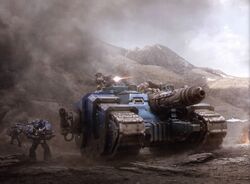
An Alpha Legion armoured infantry squad during the Drop Site Massacre of Istvaan V
When the Horus Heresy erupted and the atrocity at Istvaan III occurred, a large Alpha Legion strike force, comprising some 50,000 Legionaries under the direct command of their Primarch were conveniently situated to respond to Rogal Dorn's order to attack the Traitors at Istvaan V. This Alpha Legion contingent is believed to have comprised the combined forces of two separate Expeditionary Fleets and their support vessels, having recently returned to the Imperium to resupply and re-arm at the Forge World of Lucius after an extended series of campaigns at the northeastern galactic fringe. The Alpha Legion and their Primarch had then been supposedly all but out of contact with the rest of the Great Crusade for several standard years, and by this fact was Rogal Dorn, Praetorian of Terra, likely assured of their loyalty and lack of involvement with whatever treacherous madness had befallen Horus and his immediate coterie. This could not however have been further from the truth as their involvement in the Drop Site Massacre was to prove -- and there have even been unsubstantiated claims since that Alpharius had a hand in the planning of the Drop Site Massacre.
It is certain that the Alpha Legion had spread its web of infiltration, espionage and sabotage far and wide through the Imperium prior to the outbreak of hostilities, as was soon to be proved to bloody effect on a score of worlds as part of the Warmaster's opening gambit. At the hands of the Alpha Legion's talent for conspiracy and that of their agents, billions were to die and countless billions more would suffer hardship and disaster in the time to come. Even on planets that would not feel the thunderous footfall of the Legiones Astartes throughout the entire civil war, would the Alpha Legion's cruel plans and talent for strife wreak untold havoc. However, even as Horus unleashed the Alpha Legion to bury its fangs deep into the body of the Imperium, he neither trusted it nor its master to obey him, nor fight the war he wished them to fight once the Hydra had been unchained. History would prove this distrust well-founded.
The Horus Heresy
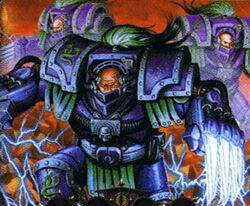
The Alpha Legion's Camallarus Squad of Terminators in ancient Cataphractii Pattern Terminator Armour during the Drop Site Massacre of Istvaan V
After the virus-bombing of Istvaan III, the presumed Loyalist Alpha Legion was one of the Space Marine Legions sent by the Emperor to destroy Horus and the Traitor Legions at their base on Istvaan V. Assigned to the second wave, the Legion instead turned on the Loyalist first wave during what became known as the Drop Site Massacre. It is thought by many that much of the Traitors' strategy on Istvaan V was planned by Alpharius and the Alpha Legion.
In the ensuing slaughter, the Loyalist Iron Hands, Salamanders and the Raven Guard were decimated. Ferrus Manus was killed by the traitorous Fulgrim of the Emperor's Children, Vulkan went missing and Corax was severely wounded. For over three months, the remnants of the Raven Guard were pursued by the ravenous World Eaters, who were intent on completely annihilating the Loyalist Legion. Their Legion hard-pressed by the Traitors, Corax and the remnants of his Legion prepared to sell their lives dearly. But their fortunes quickly changed with the arrival of a rescue force of Raven Guard Thunderhawks and Stormbirds to retrieve the remaining survivors.
By this time, it had been well-established that the Alpha Legion was well-known for their subterfuge and ability to blend-in with any environment, mimicking those that they infiltrated to gather intelligence, perform sabotage, or plant disinformation. They have also been known to use more drastic measures, such as those employed during the actions on Istvaan V during the opening days of the Horus Heresy. The Alpha Legion played a pivotal role in the infiltration of the Raven Guard to gather vital intelligence on the Imperium's defences within the Sol Sector as well as the Imperial Palace on Terra.
Part of the bargain agreed with the Warmaster was for the Alpha Legion to spread disinformation ahead of the events that had occurred in the Istvaan System, whilst seeking new forces for Horus’s cause. It was better that Horus’s version of events was heard first, casting doubt on the rumours and propaganda that soon followed in the wake of these horrific events. It was a mission Alpharius and Omegon were well-prepared to undertake. On many other worlds, Alpha Legion operatives and legionnaires sowed discord amongst the Emperor’s followers, stoking thoughts of rebellion in those who had been forced into compliance by the Legiones Astartes.
During the remainder of the Heresy, the Alpha Legion split off from the main body of Horus' forces early and did not attack Terra with the majority of the Traitor Legions, instead embarking upon a series of delaying actions in an attempt to hold potential Imperial reinforcements for the defence of Terra in place. They also engaged in smaller actions, defeating a White Scars force on Tallarn and a Space Wolves unit at Yarant. Despite their contributions, however, Horus was ultimately defeated by the Emperor aboard his battle barge at the end of the Siege of the Imperial Palace on Terra.
Aftermath
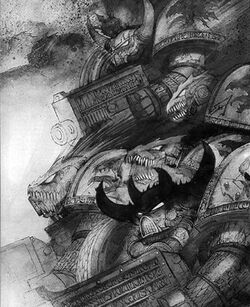
Alpha Legion Chaos Space Marines in combat
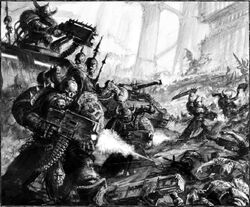
Alpha Legionaries subjugate another world.
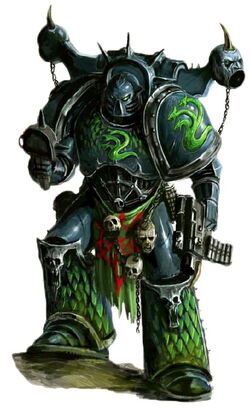
A Traitor Marine of the Alpha Legion
In the aftermath of the Horus Heresy, the Alpha Legion did not retreat to the Eye of Terror like the other Traitor Legions; instead the XXth Legion moved on into the galactic East, following new objectives of their own devising. As such, the Legion was not pursued into the Eye of Terror as so many of their fellow Traitors were, but became embroiled in a series of bitter confrontations with the Ultramarines, who themselves had been engaged in that region when Horus had assaulted Terra.
On the world of Eskrador, the Alpha Legion was assaulted by Ultramarines forces. Alpharius was reportedly happy with such a development, as it allowed him to demonstrate the superiority of his flexible, multitudinous and unexpected military strategies over the notoriously precise, methodical and perhaps even tactically moribund Ultramarines. The Ultramarines' Primarch Roboute Guilliman would prove himself the better strategist when he accurately predicted that the Alpha Legion would believe they could foresee the tactics he would utilise in the coming battle. For perhaps the only time in his life, Guiliman acted contrary to his own firmly-held military doctrines, and it was Alpharius who walked into a trap. Accounts vary as to why the Ultramarines and the Alpha Legion fought one another at Eskrador. Some say Alpharius wanted to prove the superiority of his tactics, whilst Guilliman wanted revenge on one of the Traitor Legions for the death of the primarchs' beloved Emperor, and so tracked down the traitorous Alpha Legion in the Eskrador System. Alpharius' Legion was the first to arrive and was able to choose their battleground and set the perfect trap for the upstart Ultramarines.
With access to all the records of the tactics used by Guilliman during the Great Crusade, Alpharius used this information to take full advantage of the Ultramarines' standard operating procedures. At first the battle was a stalemate between the two evenly matched Legions, but Guilliman chose nightfall to do something unexpected, leading a large portion of his forces with no lines of support or supply deep into the mountains where they deployed by Thunderhawk, Drop Pod, and teleporter in the midst of the Alpha Legion. The Ultramarines quickly took advantage of the situation and soon had the Alpha Legion's command centre in disarray. Hard-pressed by the vengeful Loyalist force, which outnumbered them five to one, the Alpha Legion was unable to fall back up the mountain valley. They were hampered by the terrain and were forced to make a last stand at the head of the valley. Alpharius himself led a furious counterattack against the Ultramarines and was slain in single combat by Roboute Guilliman. None knew that the Alpha Legion still had another Primarch, who soon adopted the role of his slain brother. This final deception would present the Imperium with an unexpected and very nasty surprise time and time again.
Having burned the Traitor Primarch's body on a great pyre, Guilliman led his Legion against the remnants of the Alpha Legion on Eskrador, only to discover that far from collapsing, the XXth Legion was mounting a series of cunning and often devastating counter-strikes. The Alpha Legion responded not by breaking and fleeing as Guilliman had expected after the death of their Primarch, but by turning on the pursuing Ultramarines detachment and harrying them so mercilessly that by the time they had returned to the main body of the Ultramarines force their casualties were almost total. After days of bitter fighting, Guiliman gave up hope of an honourable victory and departed Eskrador, ordering a massive orbital bombardment to finish the XXth Legion's survivors off. Some Imperial savants have claimed that the entire battle was some grand ploy unleashed by the Alpha Legion, though to what end none can say. Certainly, the Alpha Legion fought in the manner of the mythical beast that adorns their armour -- the hydra -- for each time one head was cut off, another two grew back to replace it.
Following the Battle of Eskrador, the Alpha Legion fractured in order to hide from the Imperium. Small, autonomous warbands were left in Imperial space where they set up secret bases in asteroid fields, on Space Hulks and on barren, unpopulated worlds. These units launched frequent attacks against Imperial military targets that had already been weakened by the Heresy and even today these warbands still pose a threat to Imperial starships, settlements and garrisons. The Alpha Legion's warbands also coordinate the spread and actions of Chaos Cults throughout the galaxy in order to instigate massive planetary revolts against Imperial rule. These insurrections are often used to lure Imperial forces away from more strategic worlds the Alpha Legion proper wants to attack, paving the way for large-scale assaults of Chaos Space Marines from the Eye of Terror.
Unlike the other Traitor Legions, most of the Alpha Legion does not reside in the Warp, but rather roams the galaxy as scattered warbands of warriors, each of which is trained to act independently of the others in pursuit of their greater cause. In this way the Alpha Legion was by and large the only Traitor Legion not to succumb to the mutations of Chaos, an outcome that may also have been dictated by their continued secret loyalty to the Emperor of Mankind. The Alpha Legion's role in spreading heretical Chaos Cults across the Imperium has earned them the loathing of the Inquisition, whose Ordo Malleus and Ordo Hereticus have devoted considerable resources to finding and destroying their secret bases. The Alpha Legion has been declared wiped out by the High Lords of Terra no less than three times, in the 31st Millennium, the 32nd Millennium and the 39th Millennium. These claims have always been disproved by the next Alpha Legion-inspired plot or rebellion that breaks out somewhere in the Imperium and proves that the hydra still has more heads to slay.
Notable Campaigns
- The Hunting of the Ak'Haireth (986-989.M30) - One of the earliest campaigns of the Alpha Legion whose dates can be well-corroborated involves the xenocide of the alien form known variously as the Ak'Haireth, or "Bone Drinkers" in the vernacular. These fungoid, predatory and parasitic life forms acquired their sentience from operating as physically interwoven gestalt "blooms". Their existence was fuelled by the slow and agonisingly painful siphoning of nutrition from living animals, primarily human bone marrow. Given to no technological creativity of their own, the Ak'Haireth operated at the edge of the western Segmentum Solar, inhabiting the scavenged voidships of other star-faring species and raiding isolated colonies and Feral Worlds unable to resist their predations. Initially encountered in the early years of the Great Crusade, the Ak'Haireth had been subjected to extermination pogroms carried out by both the Luna Wolves and the VIIIth Legion (not then yet formally known as the Night Lords) which had been thought to have been successful. However, a cowardly species, the Ak'Haireth had been wont to flee if not cornered in battle, and over time it became apparent that some marrow-blooms of the foul xenos had hidden themselves and survived. By 986.M30, reports of attacks against isolated outposts and shipping in the region of the stellar wastes near Olmec indicated that the Ak'Haireth were again dangerously growing in strength and number. The Alpha Legion, only a handful of years previously united with their Primarch, were assigned the order for the xenocide of the species before it could spread further. Alpharius and his Legion's solution to the problem was both calculated in its planning and ruthless in its execution. Firstly they divided much of their fleet into hunter-killer squadrons to hunt down the Ak'Haireth's infested voidships across the wastes, using their own predatory instincts for ambush and evasion to identify likely places the xenos would be hiding in wait or fleeing to escape pursuit. Secondly, they analysed previous patterns of infestation and attack, and quickly reasoned that, in their terror, some had given themselves over to the alien species' dominion, providing them with a tribute of living sacrifices. While in others, in return for being spared or perhaps for gain, the xenos had human aid in plotting their attacks, such covert corruption having protected them from the Imperium's eye for several decades. This dark communion the Alpha Legion used to their own advantage, infiltrating the conspiracy with their own agents, gathering intelligence and luring the largest concentrations of the parasitic marrow-blooms to their deaths in pre-arranged traps, slaying the rest in close boarding actions of their infested ships or by the mass-cyclonic bombardment of their concentrated breeding nests. The punishment for those worlds that had aided the alien was similarly brutal, as their rulers were put to the sword for their crimes, and the colonies themselves punished by the poisoning of their water supplies or the destabilisation of their climates or seismic patterns. Inside of three sidereal solar years, the Ak'Haireth had once again been hunted to the precipice of extinction, but analysis indicated that some would have fled into hiding and inevitably the threat had to be ended. In order to fully eradicate the Bone Drinkers, the Alpha Legion worked in co-operation with the Magos Biologis of the Mechanicum to create a deadly phage to help annihilate this alien menace once and for all. The Alpha Legion insidiously deployed this virus upon the worlds on which the Ak'Haireth had preyed. The humans that peopled those worlds and the Voidborn who plied the stars between those planets were infected with the virus. In the human population, the malignancy rate of the virus was as little as 7%, but to the Ak'Haireth that might feed on them or the generations born of them in the centuries to come, it was irrevocably lethal. Alpharius had won the ultimate victory against the xenos by poisoning their food supply -- Mankind.
- Compliance of Five-Twenty-Nine (Unknown Date.M30) - This was an Imperial Compliance action carried out by the Alpha Legion against an adversary of unknown origin upon the world designated Five-Twenty-Nine.
- Compliance of the Ferinus Worlds (Unknown Date.M30) - This was an Imperial Compliance action carried out jointly by the Alpha Legion and an Imperial Army sentry force comprised of the Geno Seven-Sixty Spartocid. The Seven-Sixty were a well-drilled regiment and did not spook easily. They played an instrumental role during the Compliance of the Ferinus Worlds.
- Compliance of Thorium Abominiplex (Unknown Date.M30) – This an Imperial Compliance action that was carried out jointly by both the Alpha Legion and Death Guard Legions against an unrecorded adversary.
- The Tesstra Compliance (Unknown Date.M31) - The battle to force the human world of Tesstra into Imperial Compliance has been seen by many as an exemplar of both the Alpha Legion's particular strengths and ultimately its flaws. Tesstra was at that time part of a close alliance of totalitarian colonies resistant to the Imperium's authority. This alliance, known as the "Conservation", had survived the Age of Strife through a mixture of relative good fortune and rigidly imposed eugenic control. This divided its population into highly stratified castes enslaved to their civilisation's greater needs. For the Imperium, the Conservation's worlds represented an addition to the Great Crusade's conquests; a prize that would liberate a human population of nearly eleven billion, but in order for this to be the case, the abhorrent civilisation created by the Conservation would have to be systematically dismantled. Once the Imperium's emissaries made their desires known they were fired upon and driven away, while the Conservation geared its worlds to violent defence against the Great Crusade. The Warmaster Horus, whose own forces were at the time engaged in battle elsewhere, diverted the forces of two Expeditionary Fleets, commanded by Roboute Guilliman and Alpharius respectively, to bring the Conservation to heel. The Ultramarines began to immediately conduct a campaign to engage and conquer the outer worlds of the Conservation, whilst pinning down its mobile military assets in an ever constricting noose. Alpharius and his XXth Legion did not immediately attack, but instead circled, launching probes and raids without seeming rhyme or reason. Increasingly infuriated by the Alpha Legion's lack of progress and co-operation, Roboute Guilliman is known to have openly berated Alpharius in council, demanding that the Alpha Legion learn from his own Ultramarines' method of warfare and emulate it to achieve the victory that the Great Crusade demanded of them both. Further, that if Alpharius were to place his Legion under Guilliman's full command, the Conservation could be made to fall in a matter of solar months. This demand Alpharius ignored. Through the tactical brilliance and strategic genius of Alpharius Omegon, the Legion employed their well-known deceptive tactics of infiltration intelligence gathering through the use of their human non-Astartes agents on the ground. To the Tesstrans they appeared to be delaying their invasion, appearing only as threatening spectres as more and more Tesstran forces were deployed to Tesstra Prime's defences in preparation for the inevitable attack. When the assault finally came, it sent the Tesstrans reeling, striking from a hundred vectors at once yet leaving whole swathes of the defensive lines untouched. Soon sabotage ran amok, causing severe supply shortages and Alpha Legion strike forces began to appear inside the world's capital city, making red slaughter of government facilities and security stations with impunity. Sheer anarchy reigned as the Tesstran commanders were unable to redeploy their forces from the defences not under attack back to the city. Supply lines collapsed or were cut, orders were redirected or simply failed to arrive, and entire divisions were stranded trying to cross bridge networks that had been blown apart before they could reach them. It was then that the Harrowing of Tesstra Prime truly began. Beset on all sides by Alpha Legion forces, the Tesstran forces were subsequently torn apart by the XXth Legion's super-heavy armour columns, and their own forces were advanced directly into the teeth of a vicious trap already laid for them. The battle was short-lived and effectively over, but the killing continued. As the Alpha Legion withdrew from Tesstra Prime, their task done, they left an anarchy of riot, fire and ruin in their wake. The regime and infrastructure had collapsed, and the dead and dying were everywhere in the streets, with pestilence and famine soon to follow. It is estimated that 90% of Tesstra Prime's population, both military and civilian, would not survive the battle and its aftermath. The rest of the planet capitulated in a matter of solar days. Alpharius Omegon's conduct invited censure from many quarters, especially from Primarch Guilliman, who declared the Alpha Legion's tactics dishonourable and unworthy of Astartes in a formal protest to the Warmaster. Horus was the only Primarch who openly praised his brother-Primarch and the way in which his Legion had conducted a truly masterful campaign, but the Ultramarines would never again serve directly alongside the Alpha Legion for the rest of the Great Crusade.
- Kayvas Persecution (Unknown Date.M31) – Many tribes of Orks, scattered and leaderless after the hammerblow they had suffered at Ullanor during the Ullanor Crusade, had fled to the points of the etheric compass – and many had come to rest in the Kayvas Belt, where they carved new outposts out of the drifting, mineral-rich rocks, licked their wounds while they re-armed. The Greenskin xenos soon began to strike out at nearby Imperial star systems and newly Compliant daughter colonies, and it was the duty of the Space Marine Legions to reinforce the lesson of Ullanor again. The Alpha Legion had tracked them to their lair and petitioned the Warmaster Horus for the reinforcements required to prosecute their plan of annihilation, but after the war at the world called Murder and the disastrous engagement with the civilisation known as the Interex, the Luna Wolves had been reluctant to commit ships to Alpharius’ new campaign. In the end, it was the Blood Angels who agreed to assist their cousins in the XXth Legion, with Sanguinius himself marshalling a sizable intervention to support the efforts of the 88th Expeditionary Fleet. The mission, Alpharius said, would be five standard years in execution. The Angel rejected that premise and promised it would be over in one, and he committed vessels from every active Blood Angels expeditionary fleet to the cause. Sanguinius was proved right -- more or less. Just over thirteen months after the commencement of the Kayvas initiative, the Orks were almost totally annihilated, but like animals backed into a corner they fought harder than they ever had before. The 88th Expeditionary Fleet took their warships into the Kayvas Belt and vanished from the sensors of the IXth Legion's fleet, leaving the Blood Angels flotilla at the edge of the system to wait. Soon it became clear that the mission Alpharius had been so eager to secure support for was little more than picket duty. First one at a time, then in squadrons and finally in fleets, the Orks began to flee from the Kayvas System. Each time they bolted for open space beyond the mass shadow of the supergiant sun and its asteroid belt, the Blood Angels were waiting for them. Imperial starships and Ork cruisers engaged in deadly games of cat-and-mouse that lasted for weeks on end, threading in and out of the dense dust clouds at the periphery of the star system, mercilessly hunting each other. Mighty vessels clashed again and again, but months of protracted ship-to-ship engagements and naval warfare made the Sons of Baal restless. They had been bred for battles where they could face their foes, not ranged conflicts conducted over huge spans of empty vacuum. However, the chance to fight blade-to-blade did come. The behaviour patterns of the Ork crews began to change. They eschewed what little animal cunning they had and made mistakes. Instead of showing the brutish slyness they were known for, the xenos exhibited conduct that more closely resembled panic. They would take chances, running the gauntlet of the Blood Angels' blockade when the odds were stacked against them. It was almost as if there were something at their backs that they feared far more than the guns of Sanguinius’ Legion. No one within the IXth Legion knew what the Alpha Legion had done to make the Orks run. All that was certain was that the Alpha Legion had gone dark, only rising to send regular communiqués out to the Blood Angels' blockade fleet that contained little more than a message to "maintain the line." Finally, Sanguinius tired of Alpharius’ evasive manner and sent a frigate in past the outer marker, in defiance of the rules of engagement the two Legions had agreed upon. When the frigate returned weeks later, the crew reported that they had come across no signs of their allies, only the wrecks of Ork vessels and the bodies of dead aliens. The Alpha Legion's 88th Expeditionary Fleet comprised hundreds of warships, and yet no trace of them was sighted. The tempo of the Kayvas campaign had finally reached a terminal pitch. The final remnants of the Ork forces took flight from the belt in a disordered exodus, and perished in the flashes of Lance cannons and torpedo barrages as they crossed the sentry line. At last, the Alpha Legion's starships appeared at the very edge of scanning range, apparently moving in a wall, herding the enemy towards the fringes of the system. The Alpha Legion stated they had fully exterminated the alien infestation in the Kayvas Belt, and were grateful to the Blood Angels for their co-operation. The blockade was finally over, and with the death of the final monolithic Ork wreck at the hands of the Blood Angels fleet, the campaign came to a successful conclusion, though relations between the IXth and XXth Legions remained somewhat strained.
- Assault on Nurth (Unknown Date.M31) - The Desert World of Nurth was discovered during the Great Crusade by the 670th Expeditionary Fleet under the command of Lord Commander Teng Namitjira. Nurth was a lost human colony world. The population refused to accept the light of the Imperial Truth and opted not to join the Imperium of Man, resulting in a drawn-out, protracted compliance campaign that would eventually result in the death of the entire world. The Primarch Alpharius and a force from his XXth Legion, the Alpha Legion, fought alongside the 670th Expedition during the tragic campaign to bring the world of Nurth to Imperial Compliance, but never became an official part of the 670th Expedition's order of battle. Lord Commander Namitjira remained in formal command during the operation, though of course he deferred to the Primarch's orders. When first contacted by the Imperium, Nurth was a primitive, pre-industrial Desert World with geographic features fairly typical for such an arid environment. An exception to this was the harbour of Mon Lo, in the city of the same name. The harbour, while appearing perfectly natural to the ordinary onlooker, was actually an entirely artificial construction, having been created by the xenos organisation known as the Cabal some 11,826 Terran years before the arrival of Imperial forces on the world. Before natural environmental changes had filled the harbour of Mon Lo with water, the bay had served as a giant landing pad or "waystation" for the Cabal's massive primary starship. As such, a detailed orbital scan of Mon Lo revealed features similar to that found on other worlds where Cabal waystations were built and the Cabal's mobile headquarters had come to rest for a time. Another location that featured unusual terrain was the town of Tel Khat, also known as Visages. The plain surrounding the town was littered with old, weathered sculptures of human heads, made from diorite and ranging in size from a pebble to a boulder. For unknown reasons, the ground of Nurth was coloured a striking combination of red and orange and the sky an unusually vibrant blue. This, combined with the brightness of the desert environment, meant that glare-protection was essential equipment for all military forces operating on the planet, so as to avoid disorientation and eventual eye damage. Nurth was eventually destroyed by the Nurthene themselves, as, on the verge of losing the war against the Imperial forces, the Echvehnurth, the Chaos-corrupted Nurthene military forces, activated a Chaotic weapon known as a Black Cube, an ancient weapon of planetary destruction created eons before by the first intelligent races of the galaxy. This weapon, through unknown means, transformed the climate of the planet, turning the air into noxious vapours utterly inimical to any form of life, and generating winds so strong that they scoured soil from the bedrock and raised the temperature to the point where the ocean boiled. In a matter of days, the process was complete, leaving Nurth a lifeless Dead World.
- First Battle of Paramar (006.M31) - The world of Paramar V was the scene of an invasion and overthrow of the Paramar System by the Traitor Alpha Legion and the forces of the Warmaster Horus during the opening days of the Horus Heresy. Lying at the outer northern edge of the Segmentum Solar, Paramar was a vital staging post and supply terminus for Imperial Expeditionary Fleets, vital to the outward expansion of the Great Crusade. Paramar lies in almost direct conjunction between the Istvaan System and Terra. Before even the blood spilled in such great effusion in the Dropsite Massacre of Istvaan V had cooled, Horus' generals viewed Paramar V and the vast stockpiles of military supplies cached there with covetous eyes, and drew their plans against it. With typical guile and subterfuge, the Alpha Legion launched a massive assault, following in their wake came a second armada of Dark Mechanicum barques and mass-arks drawn from forces loyal to Horus, including the Titans of the Legio Fureans. The world of Paramar was the scene of several fierce battles during the Horus Heresy, amongst which the Traitor assault on Landing Zone Secundus of the Paramar Nexus was perhaps the most bloody. The Forces of Chaos, supported by a Sub-Legio of 8-10 maniples of Tiger Eyes Traitor Titans of various classes, strode into the deserted spaceport expecting little resistance. They were surprised to meet Titans of the Legio Gryphonicus, along with support troops and armour from the Mechanicum and Loyalist forces from the Iron Warriors' 77th Grand Company. The speed and overwhelming force of the Alpha Legion's attack took its toll and the battle quickly swung full force in the Traitors' favour. Against the massed firepower of the Tiger Eyes Titans, the final Loyalist base known as Terminus could not stand. The Paramar Nexus fell and with it Paramar V belonged to Horus, its stockpiles and industry intact.
- Drop Site Massacre of Istvaan V (566.006.M31) - Noted as one of the most devastating defeats in the history of the Adeptus Astartes, the Drop Site Massacre of Istvaan V saw the Raven Guard and Salamanders Legions nearly annihilated as effective fighting forces and only the quick thinking and initiative of the Salamanders allowed a bare few Space Marines of these two Legions to escape that dreadful day. In response to the treachery of the Warmaster Horus and his betrayal of the Loyalist Astartes in the Sons of Horus, Emperor's Children, World Eaters and Death Guard Legions at Istvaan III, the Primarch of the Imperial Fists Legion, Rogal Dorn, on the direction of the Emperor who had learned of Horus' actions from the Loyalist survivors aboard the Eisenstein, ordered 7 Loyalist Space Marine Legions to Horus' base on the world of Istvaan V to challenge the Traitors. They would attack in two waves and fall under the supreme command of the Iron Hands' Primarch Ferrus Manus. The Legions comprising the first wave were the Raven Guard, Iron Hands and Salamanders. The Legions comprising the second wave were the Alpha Legion, Night Lords, Iron Warriors, and a large contingent of Word Bearers that their Primarch Lorgar had stationed in the star system. Unknown to Dorn and Ferrus Manus, the Night Lords, Alpha Legion, Iron Warriors and Word Bearers had all turned from their service to the Emperor and secretly pledged their loyalty to Horus, and been instructed to keep their new allegiance to Chaos a secret. The Iron Hands, Salamanders and Raven Guard were deployed in the first wave of the assault. After they secured the drop site, they were to have been followed by the arrival of the other four Legions. The first wave secured the drop site, known as the Urgall Depression, though at a heavy cost. Horus ordered his front line troops to fall back in a feint, tempting Ferrus Manus to overstretch his already thin lines. Against the advice of Corax and Vulkan, Manus led his Veterans against the fleeing Traitor Marines unsupported. Manus then brought his brother Fulgrim to combat. As the two Primarchs drew their weapons, the Raven Guard and Salamanders fell back to regroup and allow the second wave's Legions to advance and earn glory. However, as they returned they were mowed down by the four Traitor Legions that had landed to supposedly support them, thus revealing their new allegiance to Chaos. At the same time the apparent rout of the Sons of Horus, the World Eaters, Death Guard and Emperor's Children suddenly halted and the Traitors pressed their attack. As Horus pressed the counterattack he managed to sandwich the Loyalists between the two Traitor forces, killing most of them. Meanwhile, the Iron Hands were cut off and slaughtered to a man -- the Veteran Morlocks Terminators cut down and the Primarch Ferrus Manus beheaded by Fulgrim. The Salamanders and Raven Guard could do nothing to help the Iron Hands, and were forced to make a costly break-out with precious few of their forces. Those Thunderhawk and Stormbird gunships that lifted off and escaped Istvaan V were far fewer than those that had landed. Corax, the Primarch of the Raven Guard, was badly wounded and Vulkan's fate was unknown for some time. The remainder of the Iron Hands Legion arrived to find their Veterans and Primarch dead while the Salamanders and Raven Guard had been reduced to a fraction of their full strength, with both Legions nearly wiped out.
- Raven Guard Infiltration (006.M31) - Shortly after the Drop Site Massacre on Istvaan V early in the Horus Heresy, and unbeknownst to Loyalists and Traitors alike, the Alpha Legion managed to infiltrate the remnants of the Raven Guard Legion, surgically altering Alpha operatives to resemble dead Raven Guard Space Marines and then inserting them into the ranks of the XIXth Legion during the chaos of the Drop Site Massacre. Acting on information received from the alien organisation known as the Cabal, Alpharius Omegon believed that the XIXth Legion was going to eventually receive an extremely valuable, top-secret asset from the Emperor that would prove to be of immense value to the Traitors' cause if it could be secured. In an operation personally overseen by Omegon, the Alpha Legion managed to appropriate the asset, which turned out to be a sample of pure Primarch gene-stock and related information on its genetic manipulation that the Primarch Corax had recovered from the Emperor's gene-laboratories beneath the Himalazian Mountains in the bowels of the Imperial Palace. Playing their typical game of deception and intrigue against all sides, Alpharius Omegon misled Horus by surrendering tainted information about the pure Primarch gene-stock to the Traitors' chief geneticist, the Emperor's Children's Chief Apothecary Fabius Bile. However, Horus knew that the Alpha Legion might have infiltrated any Legion, and had ordered the Alpha Legion to be put under surveillance by other Traitor forces to prevent any double-dealing. Alpharius Omegon also mislead the Cabal, by not destroying the pure Primarch gene-stock as they had promised to damage the Loyalists' war effort, keeping it for their own benefit. However, the pure gene-stock had been infected by a daemonic virus that had been intended to make it worthless to the Raven Guard. The Alpha Legion had been assured by the Tech-adepts of the Dark Mechanicus that this daemonic taint could be removed once the Primarch gene-stock was in the hands of the Traitors, but whether this assertion proved to be correct remains unknown. A second, major objective of the Raven Guard infiltration by the Alpha Legion was the destruction of the Raven Guard's remaining stocks of gene-seed, thereby eliminating any chance that the XIX Legion could be rebuilt after the massacre on Istvaan V. However the Alpha Legion failed in this objective due to the heroism of the Astartes of the Raven Guard, and the XIXth Legion was eventually able to reconstitute itself and play a crucial role in the future history of the Imperium.
- The Tallarn and Yarant Campaigns (Unknown Date.M31) - During the Horus Heresy the Alpha Legion went out of its way to prove itself as capable as its Loyalist Space Marines counterparts. The XXth Legion inflicted stinging defeats on the Loyalist White Scars at Tallarn, a company of the Space Wolves at Yarant, and units of the other Loyalist Legions at dozens of smaller outposts.
- Battle of Eskrador (Unknown Date.M31) - After the death of Horus at the end of the Horus Heresy during the Great Scouring, the Alpha Legion and the Ultramarines Legion met in battle on the world of Eskrador, where Roboute Guilliman faced his hated brother Primarch in bitterly contested close combat. Both struck one another in an instant, each power sword making a single stroke. For a second the two Primarchs stood facing one another, than Alpharius slumped to the ground. Exalted by their Primarch's victory the Ultramarines renewed their attack and cut down every last Alpha Legionnaire. But their exaltation was short lived, as over the next few days the Ultramarines were harried from all sides by the Eskandor natives as well as remnants of Alpha Legionnaires hiding throughout the mountains. After another week of futile combat against their shadowy opponents, Guilliman ordered his Ultramarines to evacuate the planet's surface. He then used his Legion's ships to bombard the traitors from orbit. Despite Guilliman's protests that he had no wish to fight such dishonourable foes, it seems hard to dispute the fact that the Ultramarines were soundly beaten by the Alpha Legion at every turn, despite the loss of Alpharius.
- Gothic War (12th Black Crusade) (139.M41 - 160.M41) - This was a vast military campaign against the Imperium of Man launched by Abaddon the Despoiler. This conflict consisted of hundreds of planetary invasions and naval battles and only ended when Abaddon was forced to retreat to the Immaterium with the arrival of Imperial reinforcements. The only known battle the Alpha Legion took part in was the Lethe Ambush, though undoubtedly the Legion were working behind the scenes manipulating the outcomes of battles, using secret spy networks and fomenting rebellion to assail their enemies from as many different directions as possible in carefully orchestrated attacks.
- Daethryu Plague (255.M41) - The Agri-world of Daethryu Prime was suddenly plagued by a species of locusts not usually found anywhere in the sector. Thriving in the planet's warm climate the locusts multiplied exponentially, decimating food crops and causing a planetwide famine. The population had a surge of anger and unrest which they directed at the planet's ruling authorities. Within a week's time, riots broke out in every major population center and much of the local military mutinied. A Mordian Iron Guard regiment was dispatched to quell the riots but was ambushed and summarily destroyed as they disembarked from their transports by a force of hidden Chaos Space Marines. The complete loss of food exports caused major supply problems in the subsector for years, resulting in further unrest on other worlds. This hindered Imperial forces during subsequent Chaos incursions into the Segmentum Pacificus. It seems certain the Alpha Legion orchestrated much of the events that occurred in the sector, more than likely being involved at some level.
- Legacy of the Luxor Uprisings (812.M41) - A coalition of Alpha Legion warbands foments an uprising on the Munitorum provender world of Luxor, threatening the supply of war material to war zones across the northern marches of the Ultima Segmentum. The rebellion is put down by the Ultramarines, but the population is so embittered by the Chapter's actions that insurrection and rebellion flares on numerous occasions over the next century. Some strategio-savants even ascribe the fall of the entire Aradme Cluster some eight decades later to chronic under-supply in the aftermath of the 812.M41 uprising.
- Tartarus Campaign (Unknown Date.M41) - The 3rd Company of the Blood Ravens Chapter of Space Marines and its task force under the command of Captain Gabriel Angelos were sent to the aid of the Imperial forces on the besieged Civilised World of Tartarus, which had been invaded by an Ork WAAAGH!. Over the course of the campaign the Blood Ravens uncovered the planet's dark history, locating numerous sites of Chaos power and relics of the Eldar, left behind to aid future generations in continuing to battle the forces of Chaos trapped on the planet. Over the course of the fighting most of the population that was not evacuated either fell to Chaos or was slain by the Orks and very few civilians escaped from Tartarus. In truth, the Ork invasion had been only a diversion. A warband of Chaos Space Marines from the Alpha Legion, led by the Chaos Lord Baal and the Chaos Sorcerer Sindri Myr had used the cover of the Ork WAAAGH! to make planetfall undetected on the world and begin their own operations in pursuit of an ancient and very powerful Chaotic artefact present on the world known as the Maledictum. Gabriel Angelos, whose own intuition indicated that there was more to the situation on Tartarus than met the eye, disregarded the warnings of the Ordo Malleus Inquisitor Mordecai Toth and continued to hunt down the hidden forces on the planet. Finally Gabriel discovered that a force of Eldar from the Biel-Tan Craftworld had come to reseal a powerful Daemon in the Chaotic artefact known as the Maledictum that had been hidden on the planet, underneath its capital city. However the Blood Ravens broke the back of the Eldar forces, slaying the Avatar of Khaine and killing many of the Eldar warriors. Despite their intervention Sindri managed to steal the Maledictum and its key from underneath the Imperial and Xenos forces. Perhaps the most regrettable event of the fighting on Tartarus was not the many Battle-Brothers lost, but the treachery of Librarian Isador Akios, who had been an initiate with Gabriel. He became corrupted by the power of the Maledictum, and it was he who handed it over to Sindri, despite believing himself to be in control, he had been manipulated by the Chaos Sorcerer from the beginning. His treachery could not be forgiven and Isador proved the weaker when he was faced in personal combat by Gabriel Angelos. At the conclusion of the Campaign, Gabriel shattered the Maledictum with a Daemonhammer forged from a shard of the Wailing Doom, the blade of the Biel Tan Avatar of Khaine. This only released the Daemon, however, due to the sheer amounts of bloodshed on the planet which served as a sacrifice that empowered the daemon's awakening. When the Daemon was released it hinted at a connection between itself and Inquisitor Toth. It would appear that the Inquisitor was not as pure as he seemed to be. However Gabriel was unable to pursue the matter further, having to escape the planet with the wounded and the single recruit taken from the planet, Storm Trooper Sergeant Ckrius. The young Guardsmen had been taken under the wing of Terminator Sergeant Tanthius and despite being badly wounded in the fighting was taken aboard the Litany of Fury, where he began the long and painful process of becoming a Space Marine. On Tartarus the Scout Sergeant Corallis suffered grievous injuries at the hands of the Eldar's Warp Spiders, however he survived and returned to service with the aid of numerous bionic replacements.
- Ambush at Kruger Ridge (Unknown Date.M41) - Chapter Master Quesiah Ichabod of the Excoriators Space Marine Chapter had come to the world of Ignis Prime to inspect the Excoriators’ mountaintop garrison of Kruger Ridge. He found a slaughterhouse rather than a Chapterhouse, and a waiting ambush in the form of an attack by the Chaos Space Marines of the Alpha Legion. It was there, barricaded in the oratorium, that Chapter Scourge Zachariah Kersh had fallen to Dorn's Darkness, failing both his Master and his Chapter, and allowing the Alpha Legion’s victory to become complete. Kersh failed to stop the Alpha Legion’s nearly-successful assassination attempt and crippling of Ichabod, and their theft of the Stigmartyr, the ancient and revered Chapter standard of the Excoriators dating back to the days of the Second Founding. This was a devastating blow to the Excoriators' morale, and the cause of many problems for the Chapter. Ichabod was severely injured during the failed assassination attempt. Though strong, the Chapter Master’s wounds were grievous, leaving him writhing in envenomed agony. The Alpha Legion’s assassination had ultimately failed, but they had employed a virulent toxin for which the Excoriators' Chapter Apothecarion had no record, nor antidote. Chapter Master Ichabod eventually succumbed to his ultimate fate.
- Kaurava Campaign (Unknown Date.M41) - The campaign for the Kaurava System saw the Blood Ravens pitted against the Imperial Guard stationed in the system and a Holy Crusade of the Order of the Sacred Rose of the Adepta Sororitas. Despite the presence of more than enough enemies in the form of the Orks of WAAAGH! Gorgutz, Eldar of the Craftworld Ulthwe, the Dark Eldar of the Kabal of the Black Heart, Chaos Space Marines of the Alpha Legion under the command of the Khornate Chaos Champion Firaeveus Carron, and the Tau, the Imperial forces present in the system wound up engaged in brutal infighting. To make matters worse, the Necrons had been slumbering under the sands of Kaurava III, a Necron Tomb World, for millions of years and were now led by the newly awakened Necron Lord of Kaurava. The campaign proved to be a disaster for the Blood Ravens, though how events unfolded remains uncertain in Imperial records. The Blood Ravens established their presence in the Kaurava System on the second world, Kaurava II. Recognising the strength and potential of the local inhabitants of the inhospitable mountains in which the Blood Ravens established themselves, the Chapter decided to examine the possibility of recruiting from these fairly barbaric inhabitants of the system's backwater. Unfortunately for the Blood Ravens, Captain Indrick Boreale was lost along with all 5 of the Blood Raven companies under his command, essentially costing the Chapter half of its manpower in a single campaign. As a result, the Blood Ravens desperately needed to step up their recruiting process in Sub-sector Aurelia, their only remaining recruiting ground for Neophytes who desperately needed to make good the Chapter's losses during the disastrous Kaurava Campaign. The survivors of the Kaurava Campaign in the Chapter would speak of it rarely, if at all, and viewed the campaign as a terrible mistake that deeply depleted the Chapter's strength.
Legion Organisation
Pre-Heresy
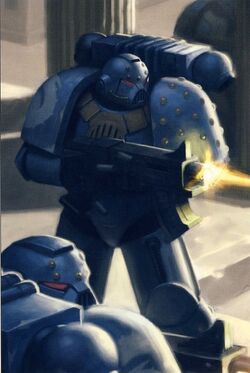
Alpha Legionaries during the Horus Heresy
When faced with the task of elucidating the inner workings and structure of the Alpha Legion, one is once again forced to deal head-on with paradox and contradiction, both by reports and the evidence left in the dust of slaughtered worlds where the XXth Legion wrecked its arts of war. Where one authoritative report might present the Legion's inner workings as highly stratified and cloaked in labyrinthine secrecy beyond any other, a different report, also by reputable sources, might describe the Legion's inner workings as surprisingly open and egalitarian in nature, with each voice bound in conflict regardless of rank or station. Certain commonalities do however exist, particularly in accounts of how the XXth Legion fought, and to some extent trained its Aspirants for war.
The first of these is the emphasis the Alpha Legion placed on unity of action and interaction within its ranks. Such co-ordination and faultless discipline was paramount to the rapidly shifting, responsive tactics Alpharius inculcated in his Legion, and the fluidity which characterised the Legion's deployments on the battlefield. It was repeatedly reported that from their first hours as Aspirants, the would-be warriors of the Alpha Legion would train and fight together as units, rather than individual soldiers; the success of each one, and even their survival, depending on the success of the unit as a whole. The exercises and trials the XXth Legion's Aspirants were put through were said to be in their way as deadly as any of the Legiones Astartes, but required both intelligence and cooperation to overcome, so that no single Aspirant might alone survive them.
A second commonality in observation of the Alpha Legion was its superlative expertise in the arts of espionage, sabotage, infiltration and assassination. The goal of which was to leave an enemy leaderless and fractured, a helpless puppet before the Legion's onslaught when it came. In counterpoint, tactics of attrition and the forlorn hope, a bloody slog of trench warfare and static defence, were things shunned by the Alpha Legion unless entirely unavoidable, and even then only ever engaged in on the XXth Legion's own terms. When the time for an attack came however, it would be a tactical mistake to underestimate the Alpha Legion's abilities in open warfare, abilities which had drawn grudging praise from both the Warmaster Horus and Sanguinius in action. The members' tactical coherence and fluid mastery of complex stratagems deployed by the Alpha Legion in the realms of infiltration and covert assault also made them masters of eloquent manoeuvres, feints and ambush in open battle. To fight the Alpha Legion's warriors and war machines in open battle was akin to fighting a single, vast and crushing entity with mystical limbs and striking fangs, but operating under a single malevolent will.
It is unclear whether the Alpha Legion ever conformed fully to the original operating strictures and organisational pattern laid out for the Space Marine Legions in the Principia Belicosa at the start of the Great Crusade, particularly as the Alpha Legion was formed long after the initial Founding of the other Legions. Outwardly though, there was extensive resemblance to the basic Legion patterns, although the command structure and the organisation of the Alpha Legion can be discerned as being radically more fluid and specialised. It seems entirely probable, given the evidence available, their an individual Legionary's role and position within the division he was attached to was adapted and changed as frequently as tactical need demanded, and perhaps to some higher system of purpose whose ultimate goal remains unknown.
The Alpha Legion's companies, battalions and Chapters (sometimes referred to as "Harrows", "Cohorts", "Hosts", and "Instruments" in shifting meaning) were formalised and broken down seemingly at the whim of Alpharius and the Legion's commanders. To this end, unit numerations were swapped and heraldry changed and adapted, personnel and resources were reassigned or removed entirely from an order of battle, only to be later again replaced. Such organisational transits were noted not only between active deployments but also even during the coarse of a particular campaign. This made the Legion's strength, intentions and deployments almost impossible to gauge or track to foe and friend alike.
This shifting and deliberate formlessness may, by some reports, have extended even to a particular Legionary's identity and rank, and is echoed in reports of uncommon similarity in both the physical features and aspect sometimes displayed by the Astartes of the XXth Legion. Needless to say, this latter phenomenon is confusingly, not constantly, observed in the record either, and while some reports speak of the Legion's members displaying a strange physical uniformity, others infer them as originating from a mixture of genotypes, while others indicate a stranger, waxy and unnatural appearance with grey flesh blank of pigment, and sees them adorned with shimmering serpentine electoos. It is entirely possible that all of these reports are equally valid. Whether surgical or memetic implantation techniques, proscribed cognitive manipulation or esoteric technologies were employed to these ends remains unknown, as does just to what extent the individual Legionaries undertook such measures voluntarily -- or perhaps were even aware of being subjected to them at all.
At a strategic level the Alpha Legion was clearly at pains to maintain a wide spectrum of military assets and capacities, its dedication to flexibility ensuring it was as capable in armoured warfare as it was in surgical drop strikes, artillery fire support or close-quarter Zone Mortalis operations. It was supported in maintaining these abilities by voracious demand for matèriel, particularly supplied byForge Worlds such as Lucius, Incaladion and Phaeton -- with some of these treaties of provender brokered directly by the Warmaster Horus, no doubt in the hope of further securing the Alpha Legion's loyalty. These arrangements do not, however, account for the full scope of the Alpha Legion's extensive panoply of war, particularly their known acquisition of rare and specialised wargear notionally only manufactored by the armouries of certain Legions and never released to others, or not yet issued outside of close prototype deployments.
A case in point is the evidence of the Alpha Legion's access to a version of Mark VI Corvus Pattern Power Armour, not then in general circulation among the Legiones Astartes, as early as the Drop Site Massacre and the First Battle of Paramar. Later battlefield recovery and analysis of this so-called "Corvus-Alpha" armour shows it in fact to be a unique variant of the Mark VI suit likely developed separately from an early prototype of unknown manufacture. This suggests that the Alpha Legion may have acquired incomplete schematics by covert means early in the project's life and chosen to develop it on their own without recourse to the Mechanicum. It has been surmised that long before the Horus Heresy was to tear the Imperium asunder, the Alpha Legion had sought to secure its own extensive facilities of manufacture and positioned numerous hidden supply outposts and arms caches, both within Imperial space and beyond it, the full extent of which will never be known. Another mysterious development encountered by Loyalist Space Marines forces at Istvaan V were Banestrike Bolter rounds. These mysterious variant bolt shells, believed to have been designed in secret within the armouries of the Alpha Legion long before the outbreak of the Horus Heresy, had it seems a sole purpose; to breach the ceramite Power Armour of Space Marines. Used openly for the first time at the Drop Site Massacre on Istvaan V, their dense explosive cores and firing stresses reduced their range and swiftly degraded the firing weapon, but their effect against the betrayed Loyalist Astartes was devastating. Fortunately for the Loyalists, supplies of these difficult to manufacture munition rounds were limited, and only the Alpha Legion and the Sons of Horus were able to field them in substantial numbers beyond that incident of brutal treachery.
Exact figures for the martial strength of the Alpha Legion at the outset of the wars of the Horus Heresy are impossible to obtain. Sources and estimates vary wildly, some making extravagant claims which may both overestimate or undervalue the Alpha Legion's manpower. Most contemporaneous accounts around the time of the Drop Site Massacre put the Alpha Legion at between 120,000 and 130,000 Legionaries strong, placing it within the middle tier of Space Marine Legion strengths. Some theorists have pointed the figure as far lower, somewhere in the 90,000 range based upon the largest concentration of Alpha Legion forces ever seen in operation in a single theatre. With hindsight and diligent corroboration however, evidence of multiple simultaneous battle-groups operating in far distant locales suggests a far higher figure than either of these estimates, well into the range of 180,000 Legionnaires which, if accurate, would make it one of the most formidable Legions in sheer size alone, a factor unguessed by both sides of the civil war that was to follow.
In terms of access to wargear and star-faring vessels, the Alpha Legion were formidably equipped. Again, true estimates are difficult to arrive at, but most pictorial and second party reports show the Alpha Legion as possessing extensive access to the most modern forms of Legiones Astartes equipment, not limited to Maximus and Tartaros Pattern Terminator Armour, the Sicaran Battle Tank and their sub-types as well as extensive stocks of plasma and Conversion Beam weaponry and specialised munitions unknown outside the Legion. In terms of warships, the Alpha Legion was known to possess a very extensive and diverse fleet, although lacking in large numbers of heavy capital ships and planetary siegecraft in comparison to most other Legions. The main strength of the Alpha Legion's fleets then was found in a plethora of different intermediate and Escort vessels, with range and speed being their primary focus. The Alpha Legion was also suspected of utilising a number of captured xenos vessels and indeed incorporating xenos technology into their warship designs –- a practise strictly forbidden without the sanction of the Mechanicum -- but given the Legion's frequent activities far beyond the Imperium's borders and its hidden strengths and bases of operation, such a suspicion was impossible to prove.
As the war of the Horus Heresy raged on, the XXth Legion demonstrated an enviable ability to replace its battlefield losses. While the war continued and many Legions saw their strength shorn away, the Alpha Legion appeared to grow stronger throughout the conflict, despite several seemingly serious defeats. Much like the Hydra of myth, where one head was cut from the Legion’s body, two more appeared to grow in its place.
Specialist Formations
- Effrit Stealth Squad - The Effrit Stealth Squad was a specialised infiltration unit within the ranks of the Alpha Legion that operated during the Great Crusade and Horus Heresy eras during the late 30th and early 31st Millennia. The Legion Seeker Squads employed by many Space Marine Legions were, according to some reports, pioneered first by the Alpha Legion to this end, and certainly such squads, along with specialised Legion Reconnaissance Squads, were common to all of the Legions' battle formations, although its use sat poorly within the more honourable combat doctrine of some of the Legions like the Space Wolves. These tactics were taken a stage further by the Alpha Legion in the creation of an elite unit geared specifically to rapidly inflicting targeted casualties behind enemy lines, known variably as the Headhunters or "Effrit" -- although this latter term may also have referred to the act of assassination, and the sowing of destruction and chaos behind the lines of mid-battle, as well as a particular unit type. This preference for high-impact strikes carried out by small, elite infantry units is evidenced by the fact that both Legion Destroyer Squads (who suffered none of the opposition found in some Legions to those so assigned) as well as speculated Alpha Legion sabotage operatives are also classified as "Effrit" in some accounts and treated as a respected Veteran cadre within the Legion. These operatives were chosen for their adaptive thinking as well as their ability to improvise. The Effrit Stealth Squad was personally led by Omegon, one of the twin-Primarchs of the Alpha Legion. Little else is known of this elite formation, as the Alpha Legion was notorious for the obfuscation and secrecy that surrounded the internal workings of their mysterious Legion.
- Headhunter Kill-teams - The histories of the Great Crusade record that it was the Alpha Legion that conceived of the deployment of Legion Seeker Squads, a unit configuration that spread to the other Legions as the Great Crusade expanded outwards. The Legion did not halt at Seeker squads however, and had since fielded a further refinement of the concept in the form of Headhunter Kill-teams. These supremely skilled infiltrators specialised in creating conditions of all-consuming chaos among the enemy's ranks, sowing confusion by eliminating key officers, positions and assets. In doing so, the Headhunters brought about a tipping point in a battle or an entire campaign, the fulcrum upon which the fate of worlds was balanced. Headhunter Kill-teams were made up of the most skilled infiltrators and assassins in the Alpha Legion, and fielded at the direct command of a senior commander. They had access to some of the most prized wargear their Legion could provide, including special ammunition conceived specifically to penetrate armour up to and including Legiones Astartes battle plate.
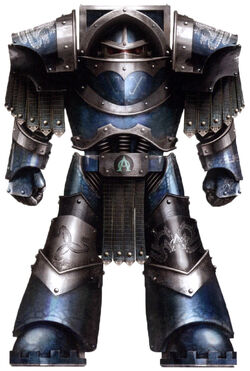
A Lernaean Terminator Strike Leader in Cataphractii Pattern Terminator Armour
- Lernaean Terminator Squad - Another designation, again driven from ancient Terran myth by the Alpha Legion, was the "Lernaean". This cognomen appears to have been given to the XXth Legion's most expert shock assault troops, particularly to dedicated Terminator companies and in some instances Legion Breacher Siege Squads and Dreadnoughts. Few knew of the Lernaean Terminator Squads, though not because the Alpha Legion sought to obscure their existence, but rather because they rarely left behind any witnesses of their deeds. Clad in Cataphractii Pattern Terminator Armour chased with baroque finery and armed with Volkite Chargers, this made them fearsome close assault and vanguard spearhead units against which few enemies could stand. In particular, battle recordings of certain Lernaean Terminator units mark them as being equipped with advanced teleportation assault capacity and specialised heavy weaponry such as compact Conversion Beam weapons and phase-field generator gear. The foremost task of the Lernaean was to swiftly isolate and destroy the most powerful frontline troops and potent battlefield assets a foe possessed, and to do so in such an emphatic and bloody manner that not only was a potential threat to the Alpha Legion's attack eroded, but the psychological shock of their attack would further damage enemy morale. Such was the calculated cruelty and cold brutality employed by the Lernaean Terminators that their reputation quickly spread beyond the Alpha Legion itself.
Legion Infiltrators
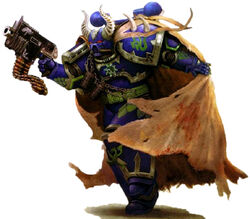
A lone Alpha Legion operative
The Alpha Legion was well known for their use of subterfuge and the innate ability of its Astartes and other operatives to blend-in with any environment. The Legion's agents mimicked those that they infiltrated to gather intelligence, perform sabotage, or plant disinformation. They also used more drastic measures, such as those employed during the Drop Site Massacre on Istvaan V during the opening days of the Horus Heresy.
Reveling in their anonymity, the Astartes of the Alpha Legion always strove to look alike, modeling themselves on their Primarchs Alpharius and Omegon who sought to keep their separate identities secret. The Alpha Legion's Primarchs had also devised an audacious plan to infiltrate another Space Marine Legion by using specially selected infiltrators. Prospective candidates for infiltration were selected for their possession of a variety of skills required for the successful completion of a mission, such as linguistic ability, a quick mind or an instinct for adaptation. These candidates would then take even more drastic steps to insure their ability to infiltrate their targets, having their minds reprogrammed psychically by the Legion’s Librarians so that they would forget their own true identities. The precautions taken by the psykers of the Alpha Legion shielded the infiltrator's mind from casual inspection by psychic or technological means.
During the Battle of Istvaan V, the Alpha Legion appropriated the bodies of many slain Raven Guard Astartes. Alpha Legion Apothecaries removed the faces from the slain Astartes and had them surgically grafted in place of an Alpha Legion infiltrator’s face; remolding the bone, tendons and muscles in order for the misappropriated face to be successfully implanted. To complete the façade, the infiltrator then ingested the flesh of the fallen Astartes, allowing their Omophagea organ to dissect and absorb the memories of the fallen Astartes. Bolstered by the abilities of the Librarians -- abilities forbidden by the Imperial anti-psyker edicts of the Council of Nikaea, but still widely practised by the Alpha Legion -- the infiltrators were able to gather what fragments they could of the dead Astartes’ life.
An infiltrator often did not know how many others were involved in a particular mission or whether or not they were successful in taking their assigned places; there could be a single operator or possibly dozens of operatives. It did not matter, for a lone Alpha Legion infiltrator was trained to act alone and act accordingly -- remaining alive and undetected until such time as it was prudent to communicate with someone from their Legion. Infiltrators were always prepared to give their lives for their Primarch and their Legion in order to successfully achieve the mission objectives assigned to them.
Once an Alpha Legion agent successfully infiltrated his assigned target, the operative had to take special care to stay constantly alert to maintain the façade that they had adopted. With the assistance of the Legion's Apothecaries and the genetic material absorbed by their Omophagea, the operative’s vocal chords and mouth would be reshaped to better resemble that of the target whose identity he had assumed, as the genetically-enhanced hearing of a Space Marine could detect any small difference that might give rise to suspicion. Living amongst those they were assigned to infiltrate, each day an operative learned a little more about their foe -- small mannerisms, turns of phrase, and protocols -- that enabled him to blend in better with his fellows, but it was not an entirely perfect process.
As an infiltrator the operative understood what it meant to be a member of the Alpha Legion, and so did not expect to be lauded or singled out for his actions -- such glory-mongering was not in the Legion’s traditions. Each operative would fulfill their purpose, take contentment from the knowledge of a mission accomplished and the praise of their twin Primarchs, and become one of the anonymous many of the Legion once again.
Other Formations
Certain records also indicate other named and specialised formations of the XXth Legion, such as the "Rhatoshaen", "Shayatan", "Quaryn", and "Echidna" whose nature, if they truly existed at all, remains mysterious. In addition, certain references are made to the "Chrythsaor" which may have referred to the Legion's Librarians (possibly encompassing a wider intelligence gathering apparatus as well), which was suspected to have been extensive before the Council of Nikaea. Though not believed to have been present at the Council, Alpharius, at least outwardly, appears to have had his Legion abide by its ruling and disband their Librarius, a stance quickly ended during the war of the Heresy.
Non-Astartes Agents
Of importance also when considering the particular structure and capabilities of the Alpha Legion was its use of human and augmented-human agents and paramilitaries. Whereas many Space Marine Legion forces utilised the manifold elements of the Imperial forces to support their efforts in the Great Crusade, and many Expeditionary Fleets utilised regiments of the Imperialis Auxilia subservient to the Legiones Astartes in their order of battle, the Alpha Legion made particular use of detached mortal elements specifically trained for tasks of espionage, infiltration and terrorism, and these were beholden to none save the XXth Legion itself in fealty. When encountering human worlds to be brought into Imperial Compliance, these augmented and highly adept agents (referred to as Sparatoi, possibly from an ancient Terran term meaning the "sown men", in some sources), would go ahead of the Legion and infiltrate the population, acting as spies, agitators and saboteurs. Operating individually or as part of a cell network, these agents and operatives often had little knowledge of each other or in many cases of who their true masters were, but were uniformly highly trained, psycho-conditioned for ruthlessness and fanatical loyalty, and were often subjected to surgical, cybernetic or biochemical augmentation to further their abilities. When encountering human worlds to be brought into Imperial Compliance, these augmented and highly adept agents would go ahead of the XXth Legion and infiltrate the population, acting as spies, agitators and saboteurs. They would encourage treachery, spread disinformation and corrosive mimetic patterns, and find or take over underground rebel or terrorist groups. Their role primarily was to promote dissent and cause widespread panic and infrastructural damage, and so seek to critically weaken an enemy before the Legion itself emerged in battle. When the Alpha Legion finally showed its hand, these elite agents and their web of prepper-agents would provide a wave of sabotage and destruction attacks, further destabilising the enemy, often at the cost of their own lives. It is apparent that prior to the Horus Heresy, these agent networks was expanded into the Imperium itself and its armed forces, becoming a cancerous presence that was only revealed as the great interstellar civil war erupted.
The XXth Legion recruited many of these non-Astartes specialists in every theatre and campaign they entered, commonly members of the other Imperial armed forces, though almost any human could be approached by the Legion for his knowledge or skills. These operatives often remained in their original position, ready to respond to Alpha Legion commands. Compromised operatives were not discarded if it could be avoided, and Alpha Legionaries would go to great lengths to retain them or hide their existence, lengths that included the fatal silencing of other Imperials. Alpha Legion operatives were tattooed with a small hydra symbol similar to the XXth Legion's badge. Further reports of actual Legionaries similarly infiltrating civilian populations by unknown means and even the rank and file of other members of the Legiones Astartes and masquerading as part of their number cannot be confirmed. Whilst known to have possessed Terminator and "stealth" squads (who appear to have worn blackened or dulled armour), the majority of the XXth Legion appears to have armed and equipped themselves in a similar fashion unless tactically imprudent. The Alpha Legion were known to operate behind enemy lines and even mingle with enemy civilian populations. In such situations they were apparently able to pass unnoticed with a combination of appropriate dress and psyker mind-clouding.
Legion Command Hierarchy
As with so much concerning the Alpha Legion, precise definition of their command structure cannot be determined with certainty, but certain patterns can be deduced as -- if not constant -- then repeated enough to have been deemed important. The first of these is specialisation. In any given deployment, a chain of command was obeyed unquestioningly, but this chain of command was a fluid one, both conditioned and highly decentralised in its manner. While a force would be notionally under the command of an officer such as a captain, the authority held by specialists in particular, such as siege masters or vigilators, was deferred to as a matter of course and was regarded as absolute and not to be questioned in their area of expertise. Likewise, each unit within the XXth Legion was expected to operate as a self-motivated and self-governing "cell" without need of exterior command, and expected to display initiative and pursue its part in the wider battle plan under its own cognisance and in any way it judged to be expedient. Such was the the emphasis on unity of action and initiative. Such was the emphasis on unity of action and initiative the Alpha Legion placed on its warriors that the battlefield co-ordination and responsiveness to changing circumstances that the Alpha Legion displayed was arguably superior to that of any other of the Legiones Astartes. The Alpha Legion's commanders seldom were observed to operate as champions or warlords in the conventional sense as might be expected of the Legiones Astartes, craving it seemed neither personal glory nor the experience of sublime clash of arms. Instead they were wont to observe the battle unfold impassively, matching the patterns of force and bloodshed it revealed, intervening only when needed by issuing orders that would tip the outcome in the Alpha Legion's favour or by direct participation, striking personally at the point of vulnerability where they would inflict the greatest damage.
In terms of honorifics and titles, the Alpha Legion seemed to have used a shifting set of terminology to convey authority and role. At times the Alpha Legion appears to have deliberately aped the systems used by other Legions (such as the Sons of Horus and the Blood Angels) although whether this was done to incorporate a proven pattern of organisation as part of a particular strategy or as some form of mockery remains unknown. Aside from these patterns, close scrutiny of the records reveals several distinctive additional divisions of command not shown by other Legions. One such unique title known to have been used by the Alpha Legion was that of "Harrowmaster" or "Jhariuk" as the leading commander given overall control of all Alpha Legion forces in a given war zone. Although their normal rank might vary, it was the task of the Harrowmaster to keep track of encompassing the shifting events of a conflict in minute detail and shape the actions of the Legion's forces accordingly, creating and aborting battle plans and stratagems with bewildering speed. The position of Harrowmaster was known to be held as a supreme accolade by the Alpha Legion, and their infamous skill at battlefield control was highly regarded (even as the Legion itself was often mistrusted) by the commanders and strategies of the other Space Marine Legions. It is noteworthy that the Harrowmasters were among the few of the Legion, save its Equerries, whose personal names are left to the open record, although whether they have any basis in reality or are merely guises worn by a single warrior or perhaps a series of individuals remains unknowable.
Post-Heresy

Post-Heresy appearance of Alpha Legion Chaos Space Marines
Even less is known about the internal organisation of the Alpha Legion since the Horus Heresy than was known before. On occasions there have been successful assassinations of members of the Legion thought to be high-ranking officers, but their removal has had little visible effect on Alpha Legion operations.
The Legion's badge, the hydra, is a multi-headed mythical beast which could keep fighting even if one of its heads was cut off. This legend seems to reflect the Alpha Legion's command structure, as well as echoing its doctrine of multiple simultaneous attacks.Alpharius Omegon believed in planning and co-ordination, and the twins always sought alternatives and multiple solutions to any given problem, with different elements working together for the end result. These doctrines, thoroughly embraced by the Legion as a whole, have apparently been continued by the Traitor Legion warbands and have proved effective, especially in the disparate and secretive way they now operate. Extensive preparations are made before actually attacking an Imperial target, including using spies and corruption to weaken an enemy's resolve. Not only is an enemy attacked from every angle, but every attack is often coordinated to achieve the most destructive results. Many actions are planned to utilise and support local Chaos Cultist activity. These cults go to considerable effort to spread propaganda, perform sabotage, and carry out acts of unrest and rebellion, providing a distraction and weakening the enemy before the Alpha Legion strikes. Furthermore, the Legion has been known to ally themselves with anti-Imperial forces including other Traitor Legions and even xenos like the Dark Eldar. On worlds far away from the Eye of Terror, daemons are less relied upon since they cannot remain stable for long enough in the physical universe to be useful. If the Alpha Legion succeeds in securing the belief of a local Chaos Cult the cultists are summoned to add to the variety of their attacks.
Legion Combat Doctrine
Pre-Heresy
At a tactical level, the Alpha Legion favoured freedom of manoeuvre and portability of firepower, and its battle tactics showed particular tendencies towards specialised reconnaissance and infiltration units in opening combat operations, to be quickly followed by the rapid deployment of fast armour, close air support and mechanised infantry units as a main strike force. Attacking from many vectors at once, as well as skillfully employing feints and ambushes, would commonly reveal a foe's weaknesses to the watching Alpha Legion commanders. They would then bring about maximum pressure against the exposed vulnerability, deploying reserves of shock troops, heavy armour and artillery as expedient to deal a shattering death blow. In order to employ these tactics, the Alpha Legion was known to have developed a number of specialised formations and units, often equipped with otherwise unknown and esoteric weapons and wargear. They were also known to form sub-divisions, referred to as "Splinters", which operated completely in isolation to achieve a particular mission or strategic goal, without regard to the safety or survival of either themselves or other members of their own force. It was often the case that other allied forces, and even the rest of the Alpha Legion deployments in the conflicts in which they operated would be entirely unaware of a Splinter's existence or mission.
Post Heresy
The Alpha Legion's Primarch Alpharius' axiom was to attack one's enemy in as many diverse ways as possible, at the same time. In practice, this doctrine manifests in a variety of ways depending on the size of the operation and locale of the battle zone. Obfuscation and skullduggery are the Legion's mantra. The Alpha Legion has been known to employ devious tactics such as flanking maneuvers, tunneling to bypass enemy defenses, diversionary tactics, disguising troops and vehicles in enemy colours, air drops and teleportation behind enemy lines, infiltration, disabling enemy transport vehicles and routes, sabotage of essential supplies, ammo, food, and fuel depots, as well as atmospheric and ecological tampering, triggering seismic and tectonic activity, coercion, bribery of enemy troops and officers and Imperial officials, disguising and impersonating Imperial officers, enlisting enemy forces, distributing propaganda to incite civil unrest and outright rebellion, organizing anti-Imperial activity and supplying heretical groups and cultists, and allying themselves with corsairs, aliens and other Traitor Legions. Many of these unscrupulous tactics are employed by the Legion after careful coordination, often resulting in an elaborate and enigmatic strategy that leaves their enemies confounded and confused. Through the use of these completely unorthodox tactics the Alpha Legion is able to deploy smaller and more highly mobile forces than is normally necessitated, for the Legion employs actual combat as only one part of their overall strategy.
Legion Beliefs
"I am Alpharius."
- —Common greeting of all Alpha Legion Astartes when confronting outsiders
The Alpha Legion live by the tenets of their Primarch who believed that only through thorough planning and decisive coordination could one's ultimate objective be achieved. By having different elements working together in a cohesive and decisive force, the Legion is able to find alternative and multiple solutions to any given problem that may present itself. This nefarious doctrine has been wholeheartedly embraced by the entirety of the Legion, having proved to be brutally effective for millennia. During the early days when the Space Marine Legions came into existence, they had set grueling tasks and trials for potential recruits. Prior to the outbreak of the Horus Heresy, the Alpha Legion was known to set these initiation trials for entire squads, not individual candidates. They had to succeed as a group or not at all. If one failed, they all failed. Foolhardy or individual heroics were frowned upon, for the overall strategic plan is paramount and more valuable than any one Space Marine. It is not known if this practice is still carried out by the Legion.
The first batch of Alpha Legionaries was notably tall and strong even for members of the Astartes, physical attributes which suited Alpharius' focus on misdirection. For the Primarch put into place a directive that, as far as possible, all Alpha Legion Space Marines had to attempt to look alike; and the visage they patterned themselves on was that of Alpharius and Omegon. As a result, all Alpha Legionaries were at the very least shaven-headed, with many going so far as to have cosmetic surgical alteration. Their height also made it easier for them to be confused with the Primarch, although the twins were still the tallest in the Legion. When asked by non-Legion members, all Legionaries gave their names as "Alpharius", even when more than one was present.
This was an extension of the Legion's philosophy that they were a body of one that could strike in many places at once. This complete solidarity with each other expressed itself in other ways. Decisions within the Legion were made in a fairly open and reasonably democratic way, with all ranks -- including the Alpha Legions' non-Astartes operatives -- allowed to interject and comment freely during planning sessions. This freedom was allowed not just on military matters -- the Alpha Legion internally discussed matters of philosophy and galactic policy that would have been forbidden or frowned upon in other Imperial institutions. Later recruits for the XXth Legion were selected by the Primarch primarily based on high intelligence and personal initiative.
Legion Gene-Seed
Unlike the other Traitor Legions that reside in the Eye of Terror, the Alpha Legion's gene-seed is not plagued by the warping influence of Chaos, though there is still evidence of mutation in their gene-seed. It is unknown if there was such a problem with their gene-seed prior to the Horus Heresy; if so, it was kept concealed. It would not be surprising if the Legion did such a thing, due to their predilection for secrecy. During one well-documented battle during the Gothic War known as the Lethe Ambush, Alpha Legionnaires that were mutated were observed hiding their warped body parts, not out of any sense of shame, but as a form of subterfuge. They would only reveal their mutations once they were upon their enemies, adding shock and revulsion to their horrified enemies.
Notable Alpha Legionaries
- Alpharius - Alpharius was one of the twenty Primarchs created by the Emperor of Mankind in the earliest days of the Imperium of Man, just after the end of the Age of Strife in the 30th Millennium. In truth, Alpharius and his brother Omegon were actually a pair of identical twin brothers. This greatest of secrets of the Alpha Legion's Primarch was apparently told to no one outside the XXth Legion, and it has always been thus. Alpharius was without a doubt the most steeped in mystery, legend, contradiction and deliberate falsification of all the Primarchs. The Primarch of the Alpha Legion shrouded himself in mystery, often moving unseen even amongst the ranks of his own Legion, appearing as just another line Astartes. However, when the time came to cast off the cloak of misdirection, Alpharius was as awe-inspiring a being as any of his other brother Primarchs. Due to the Alpha Legion's trademark secrecy extends to the records of their Primarch. There is little recorded information on his biographical background or where his homeworld originates. Following the tragic events of the Horus Heresy, the Alpha Legion did not retreat to the Eye of Terror like the other Traitor Legions; instead they moved on into the galactic East, following new objectives of their own devising. Upon the world of Eskrador, Alpharius would meet his fate. Alpharius wanted to demonstrate the superiority of the flexible, multitudinous and unexpected military strategies of his Legion over the notoriously precise, methodical and perhaps even tactically moribund Ultramarines. Both Primarchs met in combat and Alpharius was supposedly killed. Even though they had lost their Primarch, the Alpha Legion managed to soundly beat the Ultramarines, who proceeded to bombard their foes' position from orbit. It should be noted, however, that Alpharius' death is still considered suspect even by the Ultramarines, and he may still be at large. On the other hand, it is possible that "Alpharius" did indeed die and his twin "Omegon" took sole command of the Alpha Legion as the new Alpharius.
- Omegon - Primarch of the Alpha Legion and also commander of the Effrit Stealth Squad. Large portions of Omegon's Power Armour and wargear were painted black and darkened. Omegon often operated under various disguises to keep secret the existence of the Alpha Legion's twin Primarchs. Following the death of "Alpharius" upon the world of Eskrador at the hands of Roboute Guilliman, Omegon may have assumed the reigns of the Alpha Legion. His current fate is unknown.
- Ingo Pech - First Captain of the Alpha Legion during the Great Crusade and Horus Heresy era, Ingo Pech, like the majority of the Legionaries within the Alpha Legion, possessed strong physical similarities to his Primarch Alpharius, with a shaved head and gold-flecked brown eyes. Though he was physically smaller than some of the other Legionaries, he was quite strong.
- (Ma)Thias Herzog - Second Captain of the Alpha Legion during the Great Crusade and Horus Heresy eras, Thias Herzog also possessed physical characteristics nearly identical to his Primarch Alpharius. He was older than his peer First Captain Pech by twenty standard years. His bald scalp suggested that his hair was of a darker natural color, and that he shaved his head to resemble his Primarch and fellow captain. Herzog possessed blue eyes like his Primarch's.
- Armillus Dynat - Harrowmaster Armillus Dynat, known as the "Griefbringer" and "Instar-Nine", was a formidable strategist with a penchant for unorthodox and highly intricate attack plans often designed to pull apart and maim enemy fortifications before a killing blow was delivered, and was a master of integrated fast-armour and close air-support tactics. Armillus Dynat is thought to have been a theatre commander during during the notorious Tesstra Campaign and the mastermind behind the Oanessi Genocide.
- Autilon Skorr - Known as the "King-Killer," and the "Hydra's Headsman," Autilon Skorr was a Consul-Delegatus of the Alpha Legion, and was listed on the roll of honour of the Great Crusade's Council of War no less than seven times before the outbreak of the Horus Heresy, for he was frequently dispatched by his Legion's high command to demand Compliance of newly discovered worlds in the name of the Imperium. After the outbreak of the Heresy, he furthered the Warmaster's campaign of "Dark Compliance" by many bloody handed deeds. At Epsilon-Stranivar IX, the Shattered Legions would be all that stood between Skorr and greater victories.
- Sheed Ranko - Sheed Ranko was the master of the Alpha Legion's Lernaean Terminator Squads during the Great Crusade and Horus Heresy eras, and was an especially large Astartes, who doubled well for both Omegon and Lord Alpharius in diplomatic circumstances.
- Exodus - None can say whether Exodus is a single individual or one of several supremely skilled assassins operating at the behest of the uppermost echelons of the Alpha Legion. Whatever the truth, the Legionary known as Exodus ranked amongst the most skilled killers outside of the Assassin Clades of the Officio Assassinorum during the Great Crusade. His skill-at-arms was born of the convergence of the will, physiology and conditioning of a Space Marine with the fieldcraft and panoply of arms and wargear of an assassin. So adept was Exodus that he was said to rival even the marksmen of Clade Vindicare in his ability to insinuate himself into position and deliver the killing shot at the pivotal moment in a campaign. Some histories claim that as many as a dozen worlds were brought into Imperial Compliance with only a single shot having been fired by Exodus, who could achieve with one round what the expenditure of billions of rounds, charges and shells might never bring about.
- Arkos the Faithless, the Scion of Alpharius - Arkos the Faithless was a Captain of the Alpha Legion who turned Traitor along with the rest of his Legion during the Horus Heresy. Arkos is a Chaos Lord of the Alpha Legion and leader of the Alpha Legion warband known as The Faithless that intervened to support the Forces of Chaos during the Siege of Vraks. Following the defeat of the Chaotic forces on Vraks, the Faithless were destroyed and Arkos was taken prisoner by the Dark Angels Chapter of Loyalist Space Marines.
- Bale - Bale was the Chaos Lord who led an Alpha Legion warband to the Imperial Civilised World of Tartarus to find the ancient Chaotic artefact known as the Maledictum that met resistance from Captain Gabriel Angelos and the Blood Ravens Chapter of Space Marines' 3rd Company. Bale was slain by his own lieutenant, the Chaos Sorcerer Sindri Myr, who harboured his own ambition to use the Maledictum to become a Daemon Prince. (Deceased)
- Firaeveus Carron - Chaos Lord A Champion of Khorne that led his Alpha Legionnaire forces to launch a conquest of the Kaurava system. (Deceased)
- Dynat Crowbane - Following the tragic events of the Horus Heresy, during the unending bloodshed of the Great Scouring, the Traitor Chaos Warlord Dynat Mal, known as "Crowbane" for his ambush and slaughter of Raven Guard forces during the Battle of Lyx, flees to the Mandragoran Stars and gathers to him a coterie of Renegades, diabolists and Traitors thousands strong. Imperial forces sent in pursuit are repeatedly out-manoeuvred and cut apart piecemeal as Dynat's forces, now known as "The Shadowed Ones", employ guerrilla tactics and dark forces to extend their mastery over the region. After the vital Imperial outpost station at the world of Amarah in what is now the Orpheus Sector of the Segmentum Tempestus is attacked and destroyed, its entire population slaughtered and stockpiles plundered, any Imperial claim to the region is effectively severed. This sundered realm, caught beyond the light of the Imperium at the edges of the Veiled Region, becomes known as the Dark Marches and is benighted by ignorance and discord, and is shrouded from human sight.
- Sindri Myr - Sindri Myr was a Chaos Sorcerer who accompanied an Alpha Legion warband to the Imperial Civilised World of Tartarus to find the ancient Chaotic artefact known as the Maledictum that met resistance from Captain Gabriel Angelos and the Blood Ravens Chapter of Space Marines' 3rd Company. Sindri slew his own commander, the Chaos Lord Bale, and eventually used the power of the Maledictum to ascend to to become a Daemon Prince. However, he enjoyed this loft status for only a few moments before he was slain by the Blood Ravens' hero, Captain Gabriel Angelos. (Deceased)
- Nullus - Chaos Champion and lieutenant to the Daemon Prince Kernax Voldorius who was slain by the White Scars during the Hunt for Voldorius (Deceased)
- Kernax Voldorius - Kernax Voldorius was an infamous Daemon Prince of the Alpha Legion who was hunted for decades by the White Scars Space Marine Chapter and its Captain of the 3rd Brotherhood, Kor'sarro Khan. After more than a decade on the hunt, in 865.M41 Kor'sarro Khan drove Voldorius from his foremost stronghold on the Hive World of Modanna to the world of Quintus, where Kor'sarro and the 3rd Brotherhood of the White Scars formed an alliance with Captain Kayvaan Shrike of the Raven Guard Chapter's 3rd Company, who also sought to dislodge the Alpha Legion's grip on that benighted planet. Together, the two Astartes officers and their companies ultimately ran the Daemon Prince to ground and slew him once and for all. Kor'sarro Khan took Voldorius' head back to the White Scars homeworld of Chogoris (officially known to the Administratum as Mundus Planus) where it was set on a pike on the road to the White Scars' fortress-monastery, so that all who saw it might know that no foe of the Chapter ever truly escapes the Emperor's justice. (Deceased)
Notable Alpha Legion Operatives
- Jalen - "Jalen" was the designation of an Alpha Legion Operative believed to have been active on the soil of Tallarn for several years. Jalen had infiltrated the world several months prior to the famous Battle of Tallarn and after having found influential local supporters, tried to peacefully realign the world’s allegiance in favor of the Warmaster. These efforts were however twarted by the unforseeable invasion by the Iron Warriors Legion. As head of an entire cell of Alpha Legion operatives, Jalen had established a network of spies and agents both amongst the Loyalists and the Iron Warriors enabling him to venture into the loyalist shelters and even the decks of the Iron Blood. His extensive network included spezialised kill-teams and even elite assassin-squads of Legiones Astartes. Jalen’s most distinctive features were his piercing green eyes and a set of intricate ever-changing tattoos which he was able to let disappear at will. Jalen’s activities had however drawn the attention of an Imperial Agent of the Officio Assassinorum in person of Iaeo from the Vanus Temple.
Legion Fleet
The Alpha Legion are known to have possessed the following vessels:
- Alpha (Battle Barge) - Personal flagship of Lord Alpharius during the Great Crusade and Horus Heresy eras.
- Sigma-Pythonus (Basileus-class Battle Barge) - The lead vessel of the Alpha Leigon fleet that attacked Paramar V during the First Battle of Paramar in the opening days of the Horus Heresy.
- Anarchy's Heart (Despoiler-class Battleship) - The Anarchy's Heart was the personal Battleship of the Chaos Lord Arkos the Faithless and his Renegade Chaos Space Marine warband, The Faithless. Arkos utilised the Anarchy's Heart to launch raids from the Eye of Terror across the millennia following the end of the Horus Heresy. This vessel was destroyed near the conclusion of the infamous Siege of Vraks by the Angels of Absolution Chapter's Battle Barge Liberatorii Delictum and the Strike Cruiser Repentant.
- Beta (Battle Barge)
- Anax-Rho (Heavy Assault Cruiser) - Took part in the First Battle of Paramar during the opening days of the Horus Heresy.
- Lambda (Strike Cruiser)
- Occam's Razor (Strike Cruiser)
- Phi (Strike Cruiser)
- Upsilon (Strike Cruiser)
- Zeta (Strike Cruiser)
Legion Appearance
Legion Colours
The Alpha Legion, unlike many of the Traitor Legions, maintained the same basic colour scheme for their Power Armour -- azure blue, silver and green -- even after their fall to Chaos. Alpha Legion Sergeants often had green helmets with a blue stripe down the centre.
The Colours of Deceit
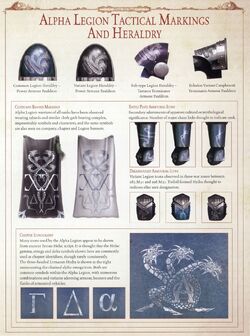
Pre-Heresy Alpha Legion Tactical Markings and Heraldry
The question of the Alpha Legion's livery and heraldry of arms is also a matter of some contention in the study of this Traitor Legion's history. It is the case that over the centuries-long conflict of the Great Crusade, all of the grey-clad Legions that first departed Terra changed their appearance to some degree -- some very dramatically so -- as the consequences of the long war and campaigning took their toll, and most tellingly when they were reunited with their Primarchs. It is also the case that given that an armed force such as a Space Marine Legion numbered in the tens of thousands strong and was very scattered across the vast distances of the interstellar void, most uniformity or conformity of livery and appearance proved impossible, even for a Legion not as stratified and fractured as perhaps the Ultramarines or the Iron Warriors.
These factions, however, do not account for the wide variance displayed by the Alpha Legion, and instead it is likely a more deliberate policy of misdirection and secrecy played its part. Variously and across multiple time periods, the Alpha Legion has been witnessed in liveries in pale grey, gleaming steel, veridian, dull bronze, sable, indigo, amaranth and azure blue -- both in main and combination. It has been variously recorded as displaying Principia Belicosa standardized rank and unit signifiers, elaborate stylised reptilian iconography of unknown meaning, and the complex logos-teknika forms favoured by the Emperor-shattered Panpacific Empire on Ancient Terra before Unification. It has also gone into battle without emblems or markings of any kind; a faceless, anonymous army of killers without distinction or division in its ranks.
If any deeper meaning is held by these changes and masquerades beyond their use to confuse the enemy and confound those who would study the XXth Legion and know its ways, one of the most outlandish and disturbing explanations is that not even the Alpha Legion itself knew its true shape and forms. This theory, postulated since the Horus Heresy, contends that only Alpharius knew the main extant of his Legion and its domain, its strength and its reach, and perhaps then even he knew it only imperfectly. By this token the Alpha Legion had become unknowable, a self-sustaining, self-replicating force, a weapon that had transcended the flesh of the Legionaries that made it up and the hand that wielded it. It would be a force whose limits and extent would forever be unknown, even unto itself, and therefore ultimately unstoppable as no enemy or influence could ever hope to fully infiltrate or overcome it from within.
It was and is indeed the case, that even before the Horus Heresy, entire generations of Alpha Legion warriors could have been trained, fought and died in ignorance of their own Legion's wider operations, purposes and goals. Entire Expeditionary Fleets could have operated never knowing the existence of mirror images of themselves, each believing that they were the only Alpha Legion bearing the name. The implications of such a colossal deceit are staggering if true.
Legion Badge
The Alpha Legion's original symbol was derived from the ancient Terran "Helac" script -- the Alpha-Omega symbol. This iconography was used by the XXth Legion throughout the early Great Crusade era. Many icons utilised by the Alpha Legion at this time, appeared to be drawn from the same ancient script. It is thought that the Helac gamma, omega and delta symbols were commonly used as the Legion's Chapter identifiers, though rarely consistently. By the start of the Horus Heresy, the Traitor Legion's icon had been replaced with that of the three-headed Laernean Hydra, a mythological multi-headed serpent that would grow back two heads for every one that was cut off. Often this icon could be seen surmounting the older, chained alpha-omega icon. Both were common symbols within the Alpha Legion, with numerous combinations and variants adorning armour, banners and the flanks of armoured vehicles.
Known Warbands
- The Faithless - A large warband of Chaos Space Marines drawn from the Alpha Legion who operate off of the Chaos Battleship Anarchy's Heart. Formerly led by the Chaos Lord Arkos the Faithless, the warband is now believed to have been destroyed during the Siege of Vraks. Arkos himself is currently a prisoner of the Dark Angels Chapter of Space Marines.
- The Shadowed Ones - A large warband comprised of Renegades, diabolists and Traitors thousands strong, the Shadowed Ones are led by the Chaos Lord Dynat Mal, known as "Crowbane", for his ambush and slaughter of the Raven Guard forces at the Battle of Lyx during the Great Scouring. Fleeing to the Mandragoran Stars he gathered his massive force of Renegades, becoming known as "The Shadowed Ones", and employed guerrilla tactics and dark forces to extend their mastery of the region. This sundered realm, caught beyond the light of the Imperium at the edges of the Veiled Region, became known as the Dark Marches, and is benighted by ignorance and discord, and shrouded from human sight.
Trivia
The name Alpharius Omegon is drawn from "Alpha" and "Omega," the first and last letters of the Ancient Greek alphabet, which also represents the "Beginning" and the "End" in Greek mythology and Christian iconography. The Alpha Legion was also the "Legion Omega," the last of the 20 Space Marine Legions to be raised during the First Founding.
Sources
- Black Crusade: Tome of Fate (RPG), pp. 29, 32-33
- Codex: Space Marines (5th Edition), pp. 42-43
- Codex: Chaos Space Marines (6th Edition), pg. 12
- Codex: Chaos Space Marines (4th Edition), pp. 20-21
- Codex: Chaos Space Marines (3rd Edition, Revised Codex), p. 40
- Codex: Chaos Space Marines (3rd Edition, 1st Codex), p. 32
- Codex: Chaos (2nd Edition), pp. 14-15
- Deathwatch: First Founding (RPG), p. 78
- Imperial Armour Volume Five - The Siege of Vraks - Part One, pp. 16, 140
- Imperial Armour Volume Twelves - The Fall of Orpheus, pg. 16
- Imperial Armour Volume Thirteen - War Machines of the Lost & The Damned, pg. 24
- Inquisitor: Core Rulebook (RPG)
- Index Astartes IV, "The Enemy Within - The Alpha Legion Space Marine Legion"
- Realm of Chaos: Slaves to Darkness
- The Horus Heresy - Book Three: Extermination (Imperial Armour), pp. 78-103, 258-265
- White Dwarf 310 (US), "Battle Report: The Defence of Cephian IV", pp. 94-113
- White Dwarf 277 (US), "Index Astartes: Alpha Legion"
- Legion (Novel) by Dan Abnett
- Deliverance Lost (Novel) by Gav Thorpe
- Age of Darkness (Anthology), "The Face of Treachery" by Gav Thorpe
- The Primarchs (Anthology), "The Serpent Beneath" by Rob Sanders
- Fear to Tread (Novel) by James Swallow
- Legion of the Damned (Novel) by Rob Sanders
- Tallarn: Executioer (Novella) by John French
- Tallarn: Ironclad (Novel) by John French
- Warhammer 40,000: Dawn of War (PC Game)
- Warhammer 40,000: Dawn of War - Soulstorm (PC Game)
- Forge World - Armillus Dynat: Harrowmaster of the Alpha Legion
- Forge World - Alpha Legion Contemptor Dreadnought

